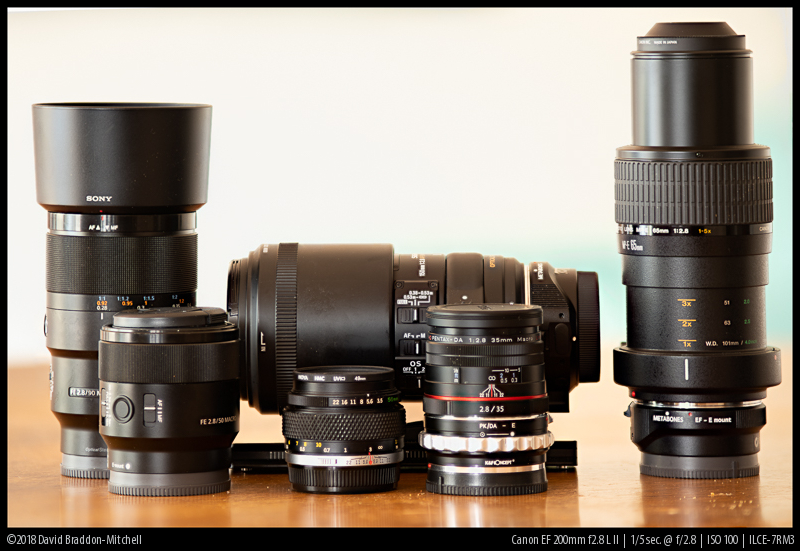
In this Guide to Macro lenses David and Phillip give you all the relevant information you need to find the right macro lens for your Sony Alpha 7/9 series camera. No matter if you are just an occasional macro shooter or pretty serious about macro.
Last update: July 2020
Macro lenses allow you to capture much smaller objects so you can reach outside of our normal human perception. They can be found in many camera bags because they do not only excel in capturing tiny insects but they also perform quite well in other roles like portrait and landscape photography. You couldn’t buy a more universal prime.
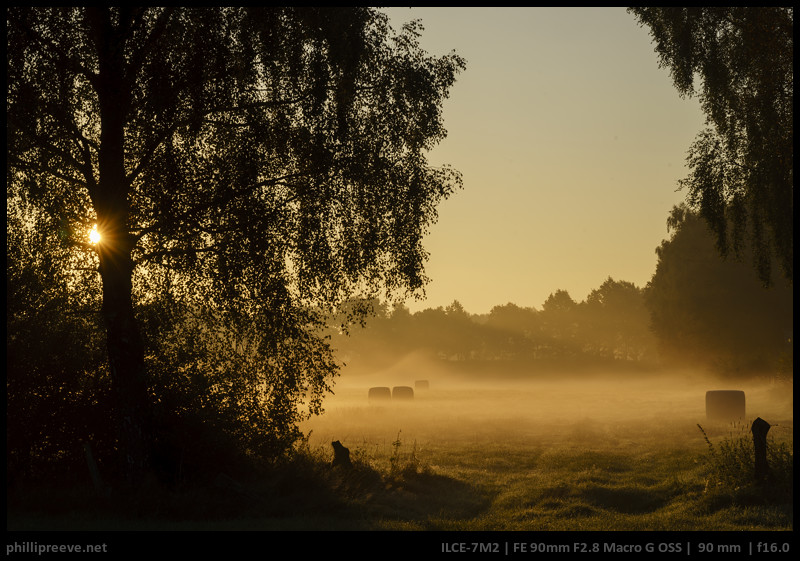
So which one is right for you? At first you should decide for yourself where you want to put your focus. Do you want to capture nothing but tiny insects? Or do you want to use the lens for other purposes most of the time and only capture occasional macro images?
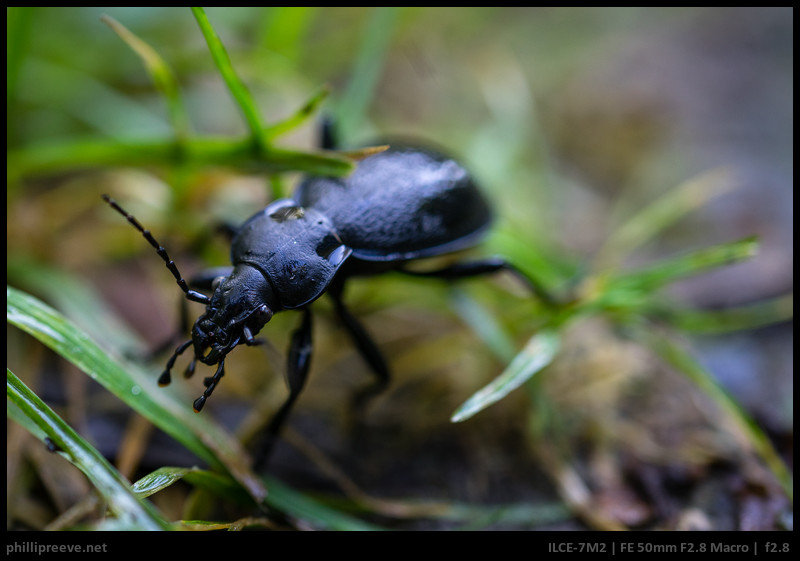
Contents
- Things to consider when buying a macro lens
- All native FE Macro Lenses
- Tokina Firin 100mm F2.8 Macro
- Voigtlander MACRO 110mm F2.5 APO-Lanthar
- Cheaper legacy Macros
- Adapted AF lenses
- Other notable lenses
- High Magnification Macro lenses
- Wide-angle Macro Lenses
- Ultrawide Macro Lenses
- The Zeiss Classic Makro-Planar Lenses
- Closeup lenses and Tubes
- Conclusion
- Support Us
Things to consider when buying a macro lens
1. Reproduction Ratio
The typical measure for how small the subects you can capture will be is the reproduction ratio. A macro-lens with a maximal reproduction ratio of 1:1 used on a Sony a7 series camera will allow you to fill the frame of an object which has the same size as the sensor which is about 36x24mm. This reproduction ratio is called life size. On a 1:2 lens your subject can be as small as 72x48mm (half life size). There are also lenses with a magnification ration greater than 1:1 which usually can’t focus to infinity.
Here is a series of images of a Hellebore flower to give you a sense of the magnifications. The series starts at 1:5 which is the kind of magnification you might get with a non-macro lens which nevertheless has closer than usual focus. You can see you get the whole flower. The series then goes to 1:2, the magnification which is the best some “macro” lenses can achieve. The jump to life-size, 1:1 is a dramatic change in the image, it no longer looks the way it is easy to visualise with the naked eye. The next two magnifications are twice life size (2:1) and five times life size (5:1). These are only achievable with specialists macro lenses that generally can only be used in the macro range.
2. Working Distance
The distance between the front of your lens and your subject is called working distance. If the front of your lens gets really close to your subject you might make it flee or cast a shadow onto it. So to capture subjects like insects this is a pretty important measure. In general lenses with a longer focal length have more a longer working distance. Since many lenses have a shorter focal length when focused very closely working distance can vary greatly between lenses of very similar focal length.
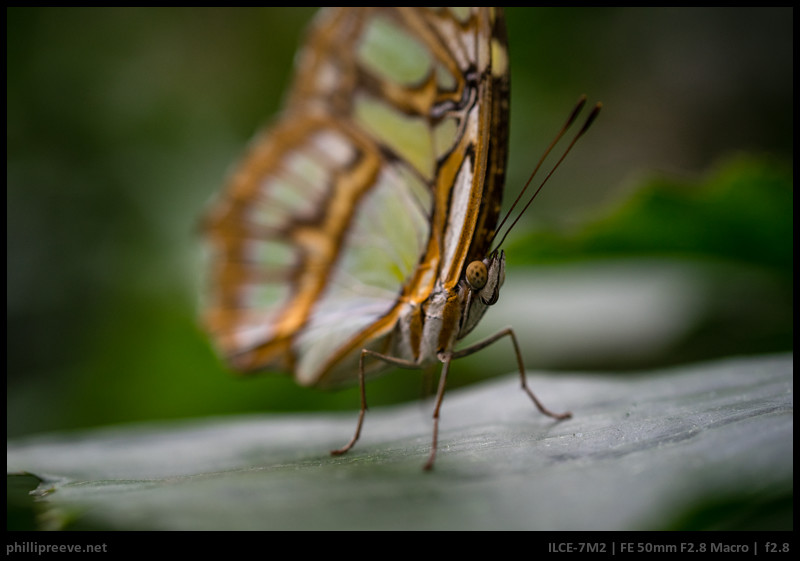
3. Focal Length – Perspective
As we have seen the longer macro lens gives you more working distance, and some say that the longer the general. But we should not ignore the fact that perspective plays a part in macro just as it does with normal photography. Longer lenses give you a flattened perspective (think of how a long portrait lens flattens faces, for better or worse). Shorter lenses make you feel you are an ant, right there in with the tiny items you are photographing. This is why one of us uses a 35mm and sometimes a 15mm macro along with the more usual lengths (50, 90, 150).
4. Auto Focus vs Manual Focus
Auto focus is not really a good idea in the macro range. Very often you will want to set the magnification and then move the lens to focus, and the danger with an AF lens is that focus may shift, even if you lock it. It’s also easier to magnify the image and get exactly the part you want in focus with manual focus than moving the AF point, using AF, locking it, and then checking to make sure it was correct.
Of course AF is useful for general and portrait work if you want your macro lens to be a general lens. But for specifically macro purposes, AF is no advantage, and generally speaking, MF lenses have better MF than AF ones. The Sony 90mm has somewhat better MF than most AF lenses: you can put it in a linear mode where you choose the magnification and moves the lens, just like with a manual lens
The Sony 2.8/90‘s Focus Clutch5. What will you use it for?
Before deciding what to buy, you need to think about what you want it for. Different types of lens are appropriate for different sorts of subject. You also need to decide just how technical you want your macro photography to be. Some lenses require that you work like you would in the lab, rather than free and easy shooting.
A common use for macro is for photographing insects and small animals in the field. This is a use for which working distance is a real issue, so longer lenses around 100mm (90-120) are indicated. Of course even longer, like about 150 or 180mm could be good, but you need to be aware that macro lenses of these focal lengths get very large and heavy indeed.
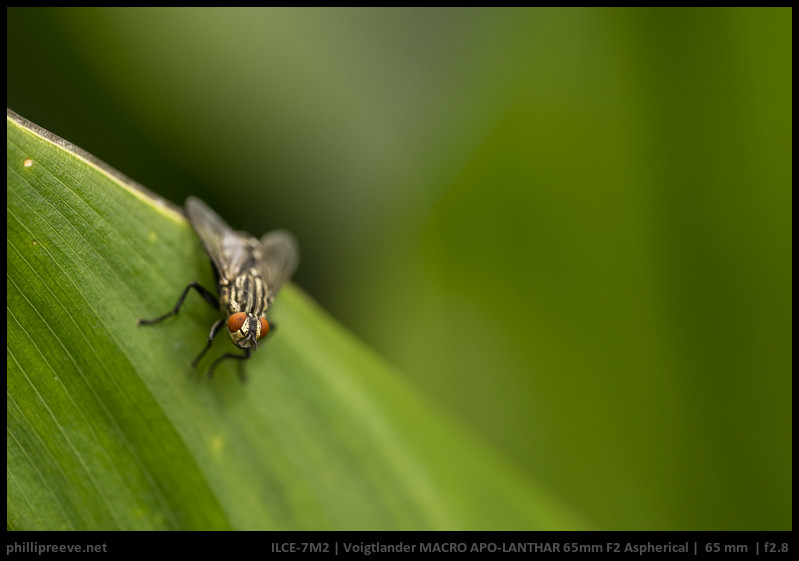
If it’s plants that you care about; say flowers or parts of flowers focal length is less crucial. If half life size is enough for your purposes an inexpensive 50mm macro is all you need. If you want life size, it would do as well, so long as you take into account the working distance issue.
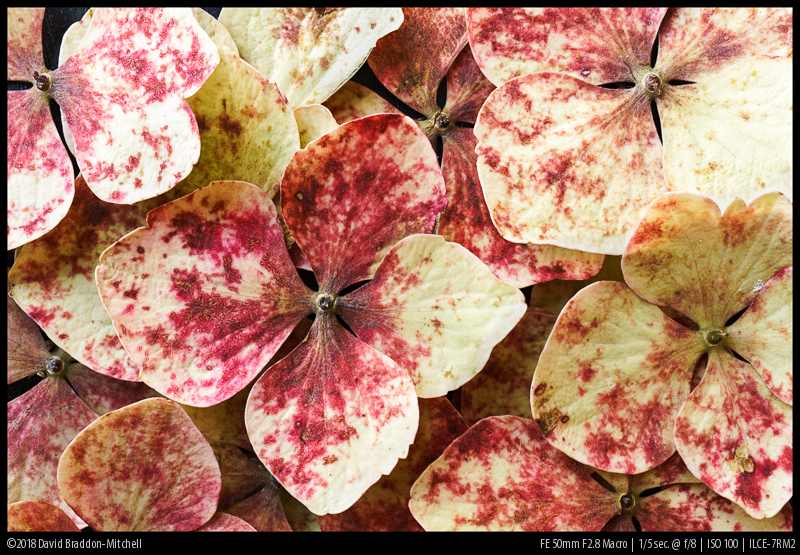
If you are interested in extreme close ups; insect eyes, tiny parts of plants—the territory of greater than life size magnification—you need something more specialised, like the MP-E we discuss here, the new Laowa, or messing with microscope objectives on tube lenses, or enlarging lenses etc. But be warned. This work generally requires a kind of stage to display your subject, heavy tripods for camera and stage, a focussing rack (ideally electronic) to move your camera back and forth to focus, focus stacking software, and perhaps lighting. It can be and absorbing hobby, but it’s not a carefree activity like taking a 50-100mm macro into the garden or wilderness and shooting what takes your fancy
All native FE Macro Lenses
If you purchase the lens through one of the affiliate-links in this article we get a small compensation with no additional cost to you.
Sony 50mm f/2.8 Macro
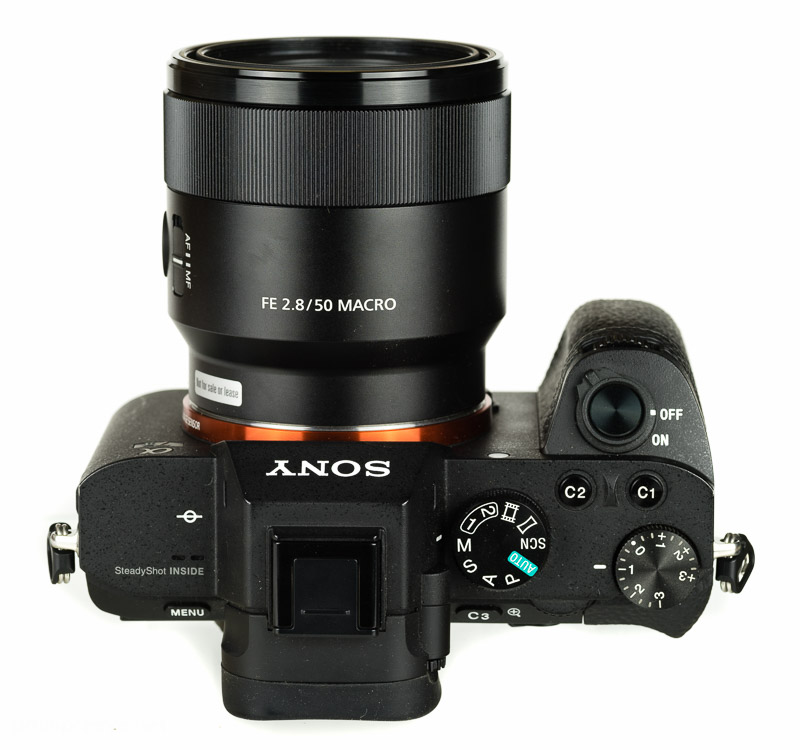
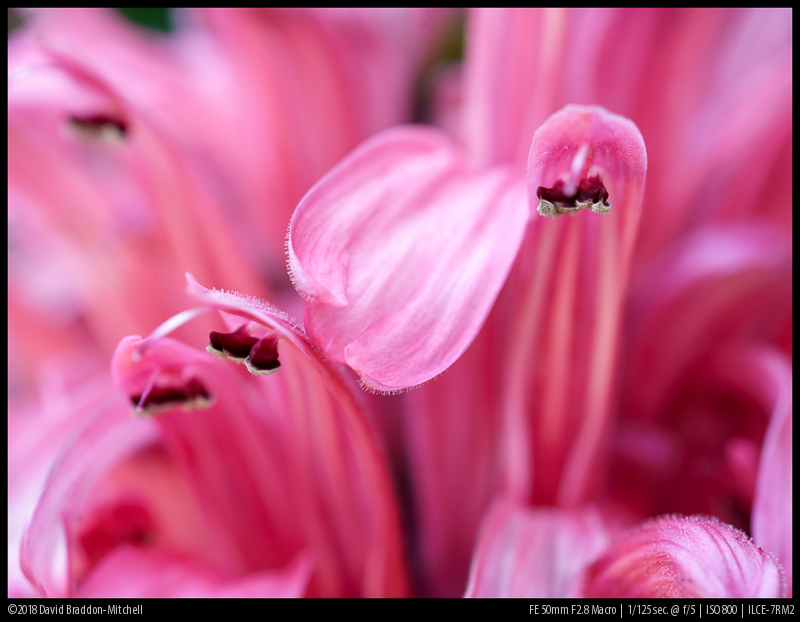
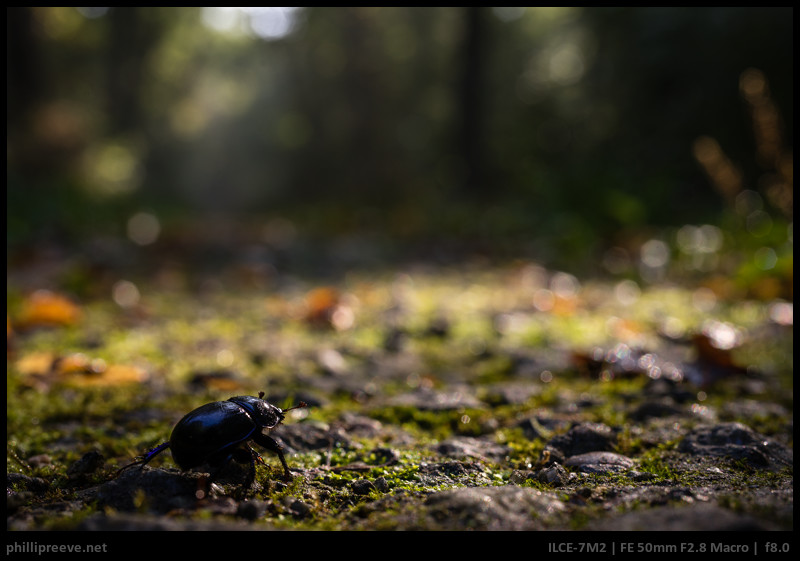
| Strengths | Weaknesses |
|
|
Recommendation: This is one of the more affordable Sony FE lenses which results in a few operational compromises but no real optical compromises. For many macro applications the focal length and working distance of just 45mm from the front of the lens at 1:1 will be a limitation. Recommended to those who want a light and affordable hiking lens for closeups in nature.
Length: 71mm | Diameter: 72mm | Weight: 236g | Filter Thread: 55mm | close focusing distance (1:1): 4.5cm | Price (July 2018): $498
Our Review | BHPhotoVideo | Amazon.com | Amazon.de | Ebay (affiliate Links
Voigtlander Macro 65mm F2 APO-Lanthar
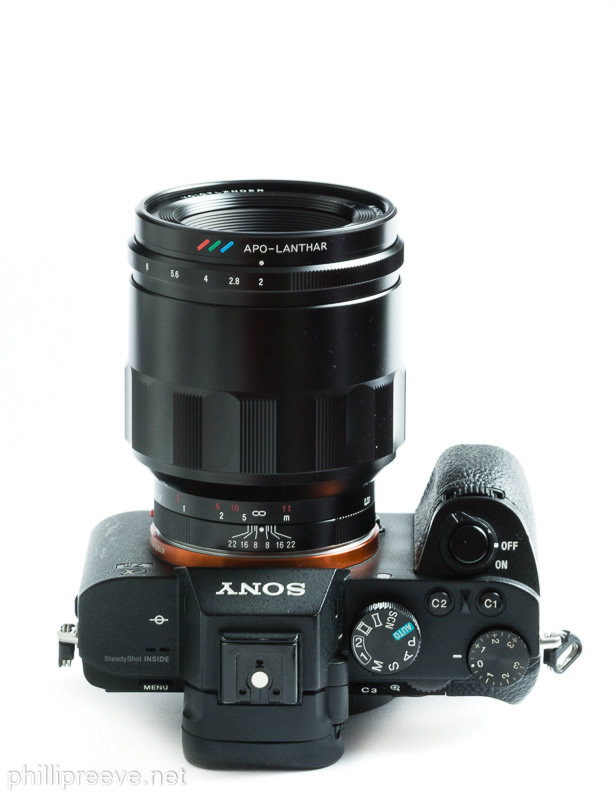
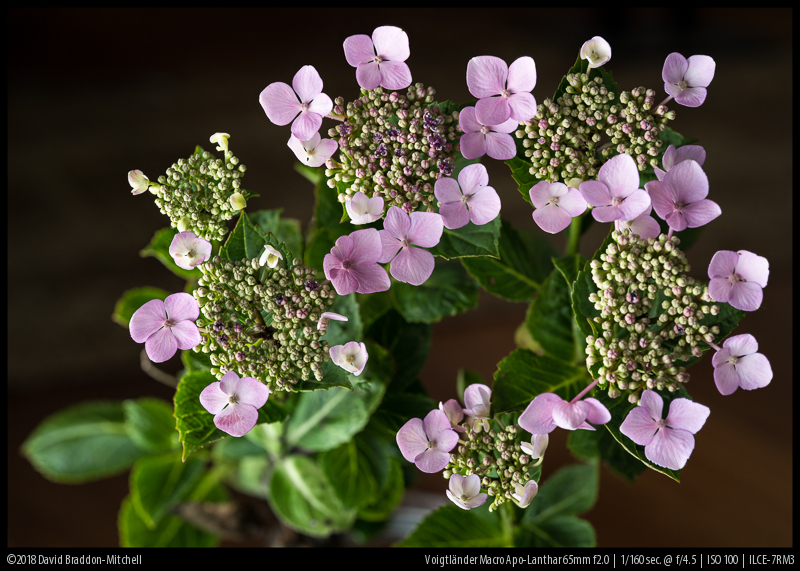
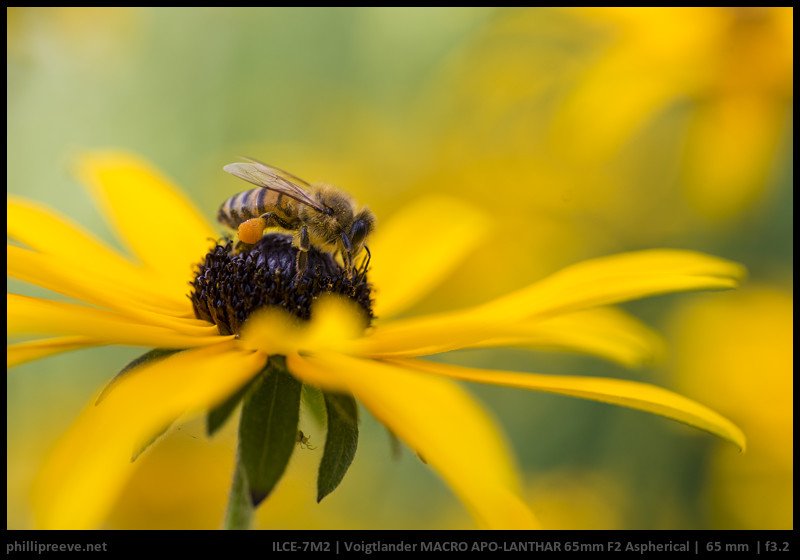
| Strengths | Weaknesses |
|
|
Recommendation: Optically this is one of the very best lenses you can buy today. It is a manual lens which some (like the authors of this blog) see as a bonus but many will see an issue in this. Since it only focuses down to 1:2 we would recommend it more as a general purpose lens which can also work well as a macro lens for some applications than as a dedicated macro lens.
Length: 91mm | Diameter: 78mm | Weight: 635g | Filter Thread: 67mm | close focusing distance (1:2): 15.5cm | Price (July 2018): 999€/$999
Our Review | BHPhotoVideo | Amazon.com | ebay.com | ebay.de (affiliate links)
Sigma Art 2.8/70 Macro
This is the only lens we haven’t used ourselves so the following assessment is based on reliable sources.
| Strengths | Weaknesses |
|
|
Recommendation: Recommended to those who want the performance of the Sony 2.8/90 for half the price and who can work with the slower focusing as well as the significantly shorter close focusing distance and focal length.
Length: 105.8mm | Diameter: 71mm | Weight: 562g | Filter Thread: 49mm | close focusing distance (1:1): 70mm | Price (July 2020): $469 | review (EF-version) | User Report on mirrorlessons.com
Amazon.com | B&H | Ebay.com | Amazon.de (affiliate links)
Sony FE 2.8/90 G OSS Macro
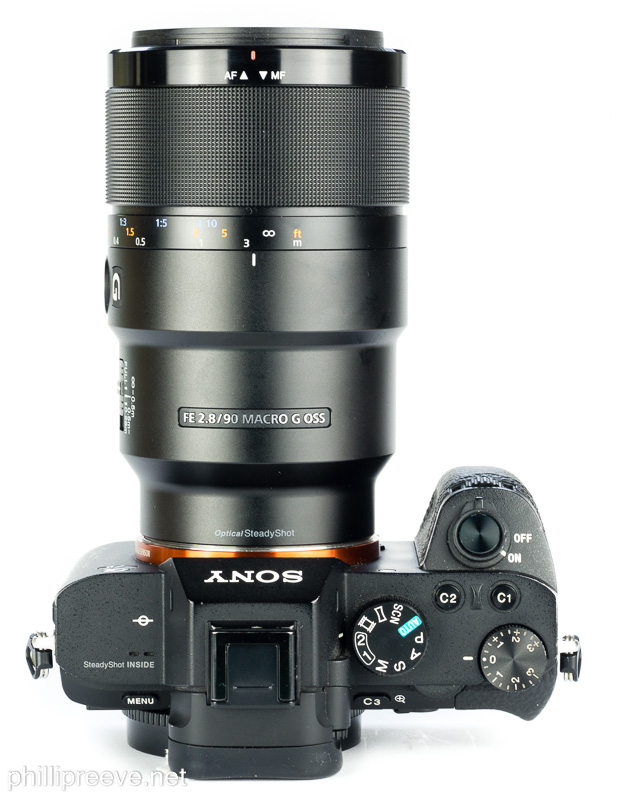
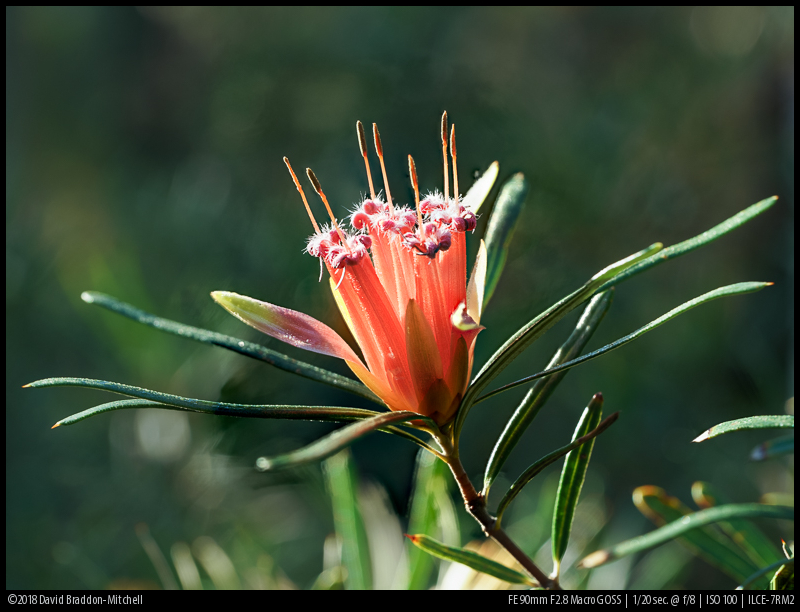
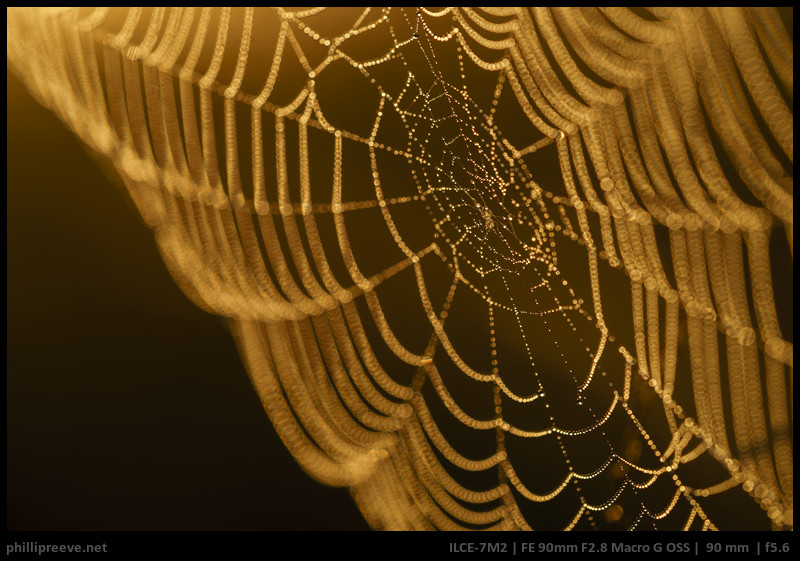
| Strengths | Weaknesses |
|
|
Recommendation: If you are more serious about macro work this is your best lens in the system but it also works well for landscape and portrait work.
Length: 130,5 mm | Diameter: 79mm | Weight: 602g | Filter Thread: 62mm | close focusing distance (1:1): 14 cm | Price (July 2018): $1098
Review | BHPhotoVideo | Amazon.com | Amazon.de | Ebay (affiliate Links)
Tokina Firin 100mm F2.8 Macro

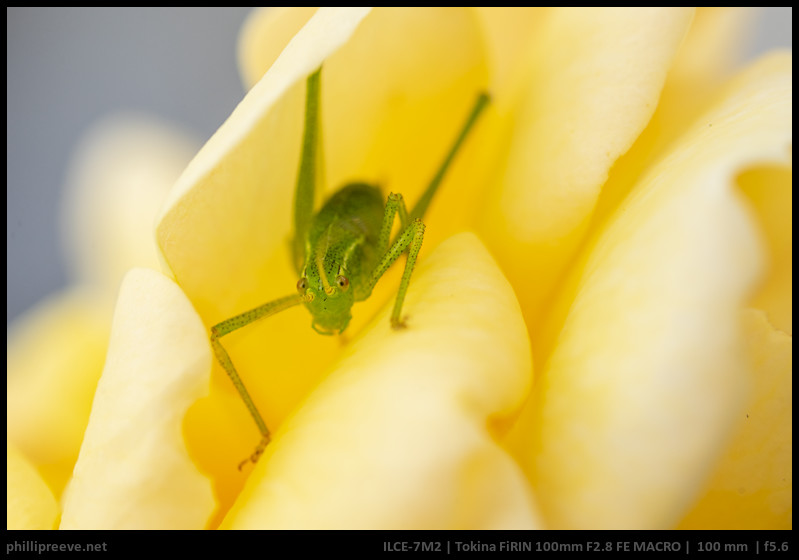
| Strengths | Weaknesses |
|
|
Recommendation: While you can certainly get decent results with it we find it hard to recommend since the cheaper Sigma 2.8/70 doesn’t have the same CA issues and better sharpness while the Sony G 2.8/90 is a better lens in any regard.
Length: 123 mm | Diameter: 74mm | Weight: 570g | Filter Thread: 55mm | close focusing distance (1:1): 11.5 cm | Price (August 2019): $599
Review | Amazon.com | B&H Photo | Amazon.de (affiliate links).
Voigtlander MACRO 110mm F2.5 APO-Lanthar
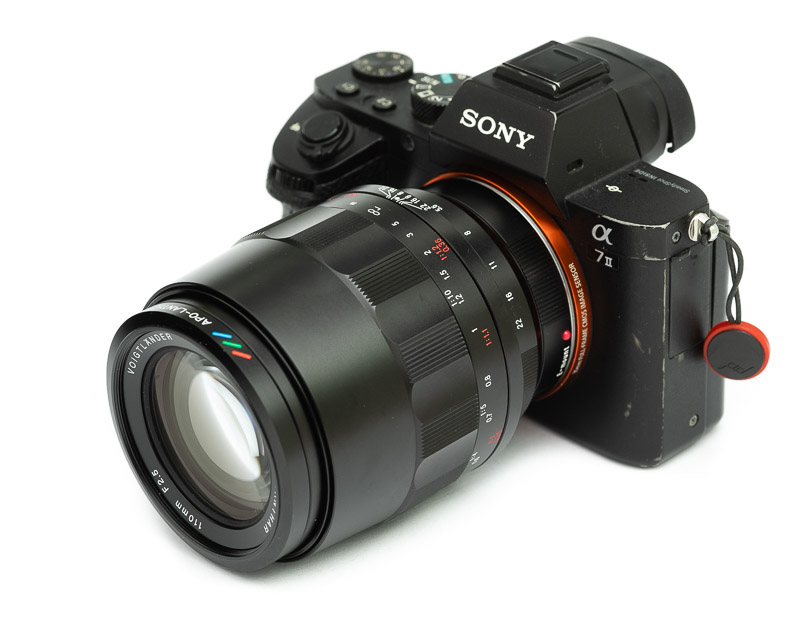
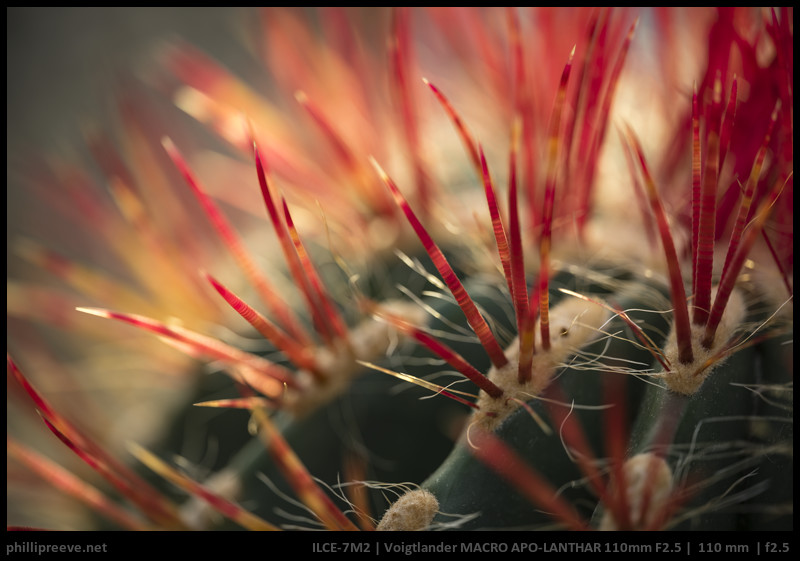
| Strengths | Weaknesses |
|
|
Recommendation
An outstanding lens. The Sony 2.8/90 is a tad sharper with a little higher contrast at 1:1 but at longer distances the Voigtlander is superior. If you want a longer manual focus lens and also an excellent macro the Voigtlander is an excellent choice.
Length: 99.7 mm | Diameter: 78.4 mm | Weight: 771 g | Filter Thread: 58mm | close focusing distance (1:1): ? | Price (July 2018): $1098
Review | at CameraQuest or B&H (affiliate links)
Cheaper legacy Macros
Olympus OM Zuiko Macro 50mm 1:3.5
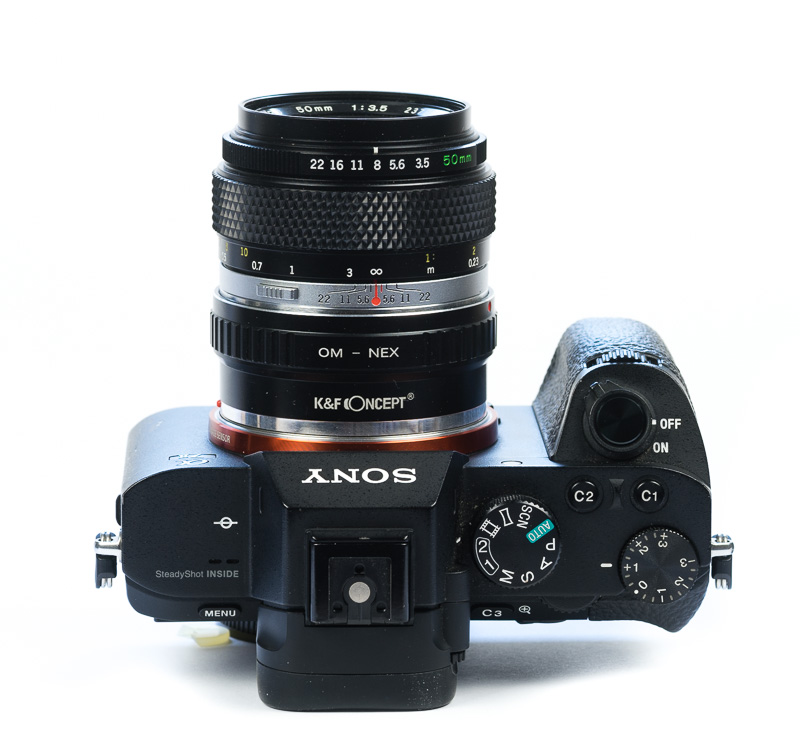
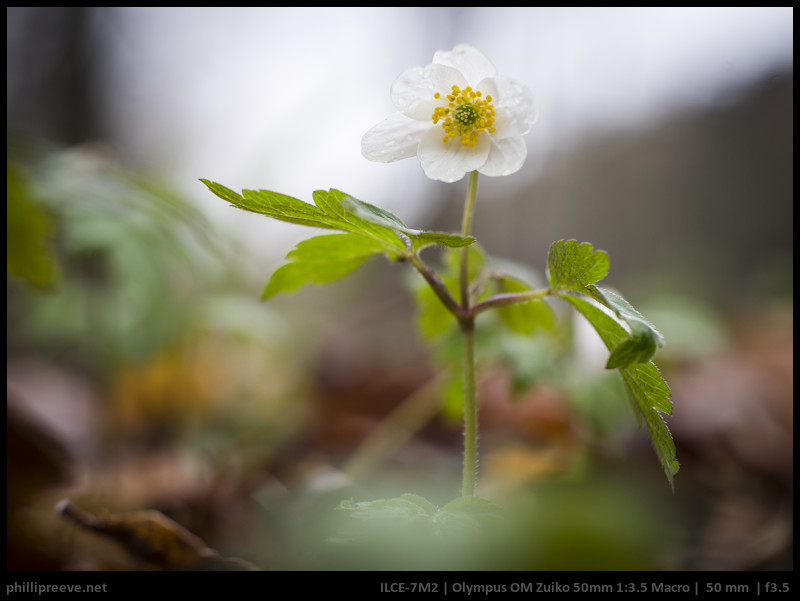
| Strengths | Weaknesses |
|
|
Recommendation: If you are on a tight budget the small Olympus can be an attractive solution. It comes with a few compromises but those won’t keep you from getting good results.
Length: 68 mm (adapter included) | Diameter: 60mm | Weight: 200g | Filter Thread: 49mm | Price (June 2018): $40
Review | Amazon.com | Amazon.de | Ebay (affiliate Links)
Tokina AT-X Macro 90mm 1:2.5
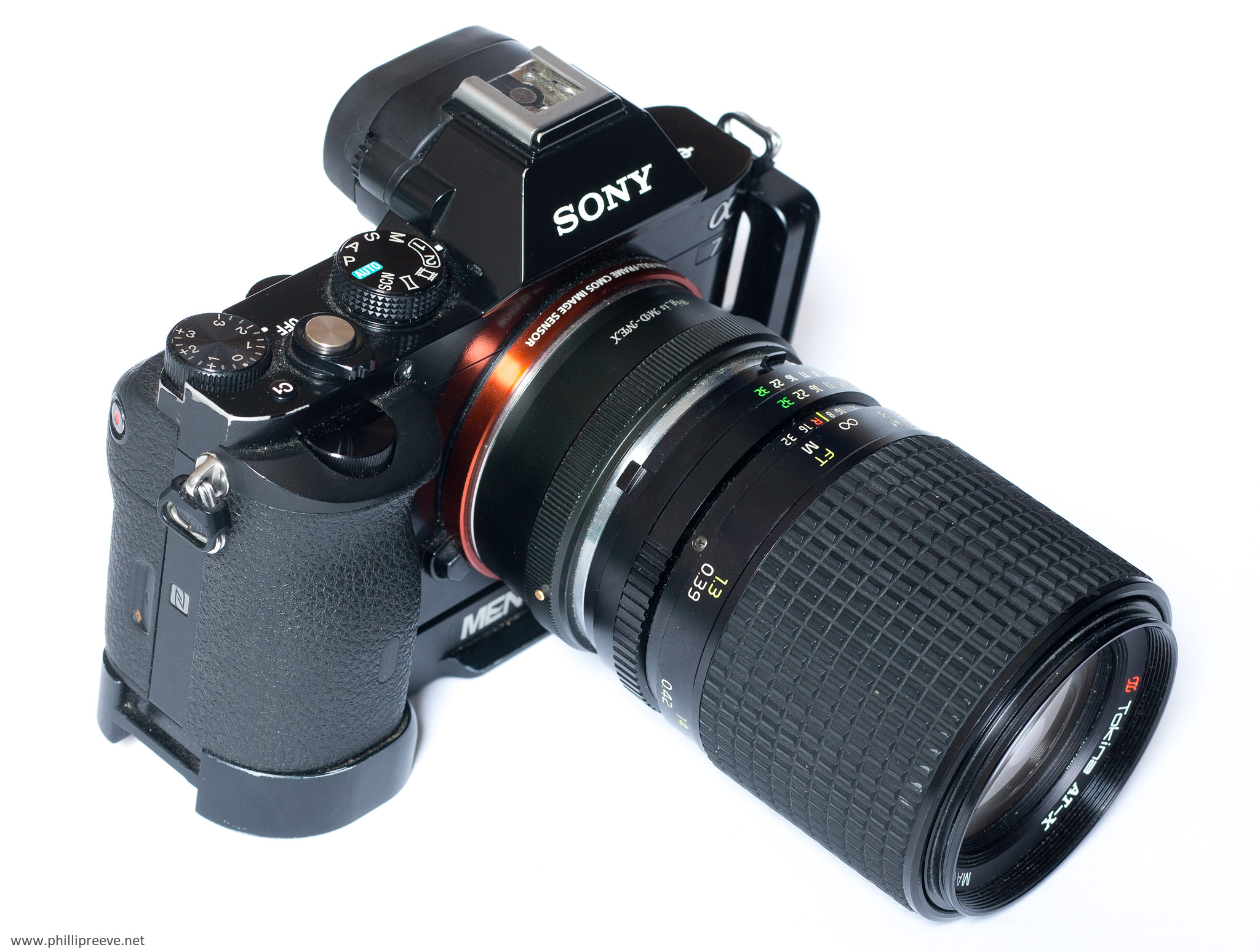
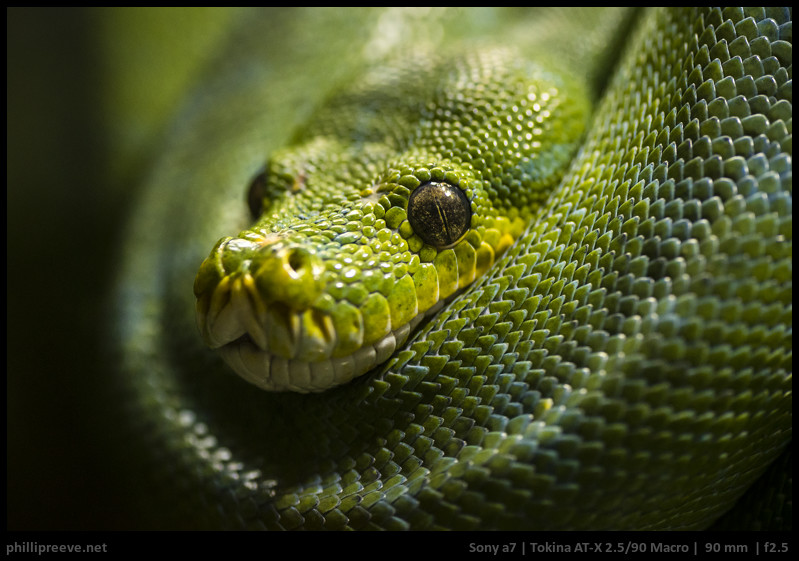
| Strengths | Weaknesses |
|
|
Recommendation: This is one of the finest legacy lenses you can buy and a joy to use. It comes with one significant drawback and that is weak flare resistance. Recommended if you are on a moderate budget and enjoy manual focus.
Weight: 530g | Filter Thread: 55mm | Price (June 2018): $300
Review | Amazon.com | Amazon.de | Ebay (affiliate Links)
Honorable mentions
We haven’t used these lenses personally but have heard good things about them from usually reliable sources.
- Tamron SP 2.5/90 – A more affordable alternative to the Tokina 2.5/90.
- Nikon 2.8/55 Macro – Seems to perform a bit better than the slower but smaller and cheaper Olympus OM 3.5/50.
Adapted AF lenses
Canon EF 100mm f2.8 L
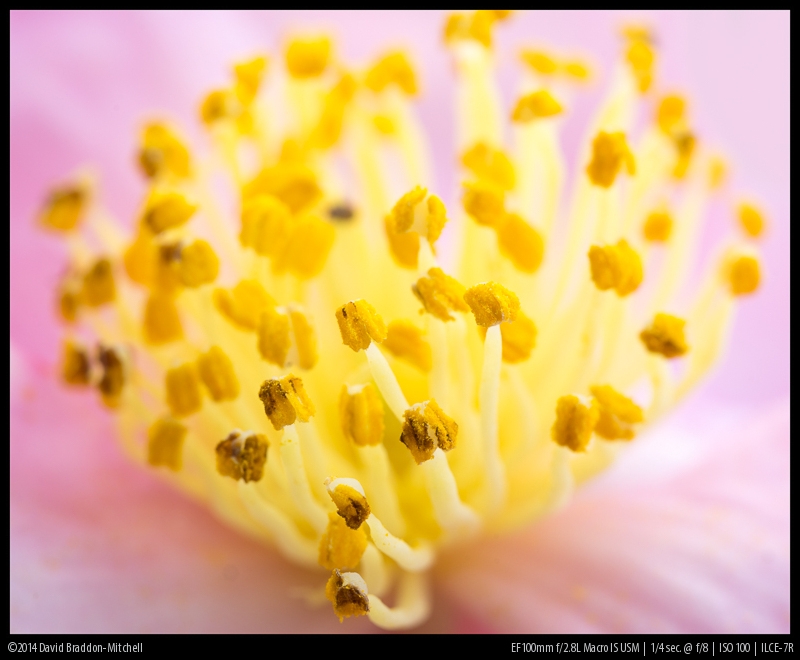
This classic Canon macro lens adapts well on the Sony system. Based on just one copy of each, it has marginally less microcontrast and resolution in the close macro range compared to the Sony 90, and perhaps a tiny bit more at infinity. It’s still a touch less good than the Sony at portrait type distances. Realistically though these are small differences which won’t affect your images. We would recommend the Sony 90 just because it’s native and handles a little better, but if the Canon comes up at a good price it is a very fine option. The older non-L EF 2.8/100 is almost as good, and can be had at a very low price if you look, and is perhaps the best budget short tele macro to be had if you don’t mind adapting. It’s worth adding that Nikon made short tele Micro-NIkkor lenses that were well thought of, and perhaps as good or better than the older Canon. None of us have any first hand experience of these, but if you find one at a good price it might be worth experimenting.
| Strengths | Weaknesses |
|
|
Amazon.com | B&H |Ebay (affiliate Links)
Sigma 150mm 2.8mm EX DG OSS Macro

This is a large and heavy lens, but it adapts well with the MC-11. Its longer perspective suits many images, and the extra length gives useful working distance. There are two versions, this one and the earlier non OSS version. Some reports claim that that the earlier one is slightly better, others that the later one is. We think probably this is all down to sample variation and it’s hard to say which is to be preferred, though the later one may have better coatings, and the OSS works well in combination with Sony IBIS using the adapter to give stabilisation which works well for non-Macro purposes. It’s a very good sharp lens, and both David and Bastian use it for long macro purposes. The Sigma 180mm macro lens is a little better still, but it’s much heavier even than this lens, so we think the 150 is probably the best overall trade-off for a long macro. The Canon and Nikon longer 180-200mm macro lenses are fine, but they are older designs, not quite as sharp, big and heavy and generally more expensive.
| Strengths | Weaknesses |
|
|
Amazon.com | B&H |Ebay (affiliate Links)
Other notable lenses
Affordable AF lenses
If you are on a budget also check out these three lenses which we haven’t used but they have tested well enough elsewhere:
- Sigma EX 2.8/105
- Tamron AF 90mm f/2.8 SP Di
- Minolta AF 2.8/100 – Needs the clunky LA-EA4 adapter to have AF
They are under $200 used. You will have to use them on an adapter and compromise on quite a bit on handling and a little on wide open performance. But for macro images they are excellent performers.
Semi-Affordable manual lenses
We haven’t tested these but they might fit your needs.
- Olympus OM 2/90 – Only 1:2 and some CA but sharp and nice bokeh while being not that large. Not good but still reasonable price/performance ratio.
- Mamiya 120/4 A – pretty big since it is a medium format lens but reputed to be a good performer.
Less affordable lenses
These lenses enjoy a somewhat legendary status. Whenever we have tested “legendary” lenses in the past though we were a bit disappointed and we are pretty sure that a Sony 2.8/90 will actually give you a better performance especially at macro distance. But that’s not all that counts for many. We haven’t tested any of these so take our short comment with a grain of salt.
- Voigtlander APO 2.5/125 – very good CA correction and bokeh but expensive and not that reliable.
- Leica APO-Macro-Elmarit-R 100mm f/2.8 – Good but not great CA correction and notable focus-shift.
- Coastal Optics 4/60 – Excellent CA correction even outside the visible spectrum. Bloody expensive.
- Zeiss APO-Makro Planar 4/120
High Magnification Macro lenses
High magnification macro is the realm between life-size, and say 5x magnification where people start calling it Photomicrography. Of course the exact border is vague. Photomicrography is of course a highly specialised technical pursuit, but high magnification macro is already getting quite technical. Some people use, for example, the Canon MP-E handheld with flash, but generally this is a job for a tripod, and very likely for focus stacking, because depth of field is so thin at these magnifications that you usually need to stack a few or even many images
Canon MP-E 65mm f2.8
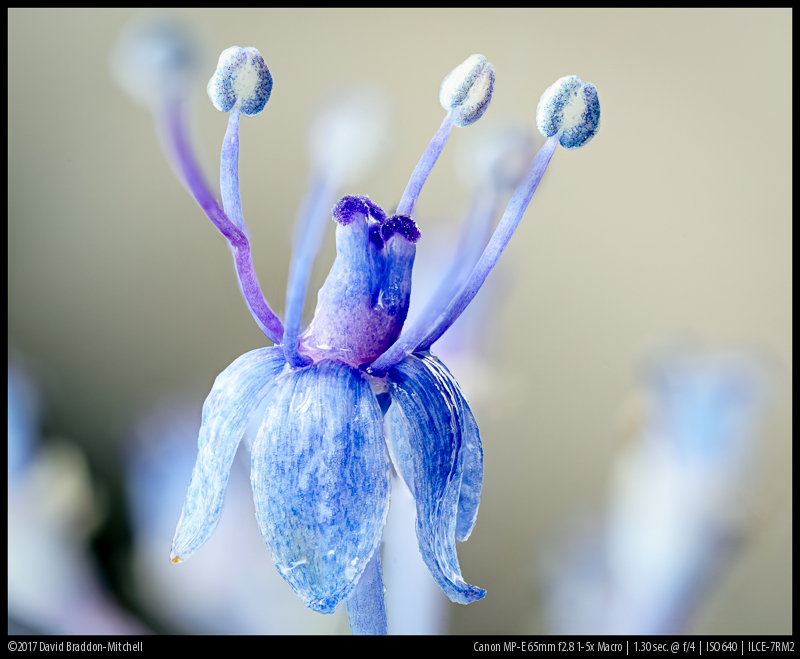
This may seem to many a cumbersome lens, but for the high magnification macro photographer it made things so much simpler. Before this, we typically used a bellows unit, and a set of specialised lenses optimised for different magnification ranges. The Canon MP-E is one lens, which can set to any magnification between life size and 5x. It’s not an easy lens to master. For one thing, it performs best wide open over most of it’s range, perhaps best at f4 for life size work. This is because at these magnifications diffraction sets in very early. This exacerbates the depth of field problem which is already there due to the high magnification, and makes focus stacking essential for anything except a deliberately arty ultra thin DOF look. But for anyone prepared to work slowly and deliberately, it’s the tool of choice at these magnifications. If you want to save money, and are handy, old enlarger lenses mounted on helicoids or bellows are an alternative, and we look forward to checking out the new Laowa.
| Strengths | Weaknesses |
|
|
Amazon.com | B&H |Ebay (affiliate Links)
Laowa 2.8/60
Laowa is known for unconventional lenses and their first lens is no exception since it is the only macro we know of which allows both a magnification of 2:1 (twice life size, not half) and infinity focus. We haven’t used it ourselves but going by other people’s reviews it seems to good a decent performance at macro distances when it is stopped down but comes with severe vignetting and distortion at longer distances. Since it is rather affordable it could be an attractive option for some none the less.
Weight: 503g | Filter Thread: 62mm | Price (July 2018): $399
Laowa 2.8/25 2.5-5x Ultra Macro
Just released we have no experience with this lens but it allows you to take extreme closeups at 5:1 to 2.5:1 for a pretty low price.
Manufacturer Homepage | Weight: 400 | Filter Thread: N/A | Price (July 2018): $399
Wide-angle Macro Lenses
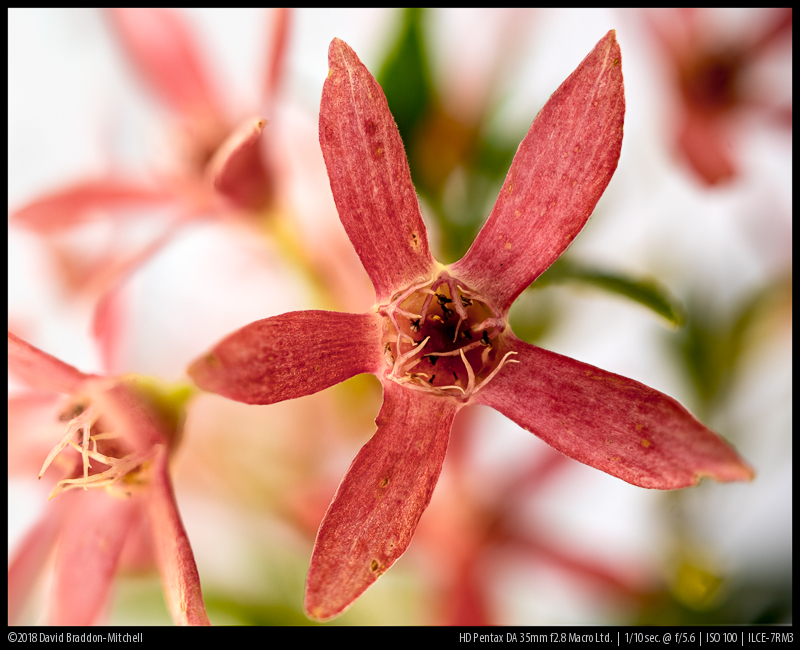
Some super high magnification macro lenses have short focal lengths like 20mm, but for reasons that need not detain us this doesn’t mean they are really wide angle in the ordinary sense. By wide angle macros here we mean ordinary macro lenses up to 1:1 which are wider angle than a ‘standard’ 50mm. Why would you want one? The usual orthodoxy is that working distance—the distance between the front of the lens and the subject—is critically important, and usually the longer the lens the greater the working distance. People often complain that 50mm macros have not enough working distance. A 35mm will have less. So, again, why would you want one? Well the working distance does make it a bit harder to handle, but being a bit closer to your subject gives you an “involved” perspective, and slightly more sense of the environment which can be very nice for some images. It wouldn’t be your first macro, but if you are already keen, or become keen, we recommend one.
But no-one makes one for full frame! You have two choices; play with a wide enlarging lens on bellows or tubes, or adapt an APSC lens.
The second is easier. Camera makers produce 35mm APSC lenses because they are 50mm equivalent on an APSC body. But at macro distances, these lenses often cover the a full frame sensor with good results.
Our prime recommendation here would be the Pentax HD 35mm f2.8 macro, which on a decent adapter gives good results. If you want to save some money, the same optical formula is used in a Tokina lens whose main drawback is terrible coatings resulting in bad flare, but in some light that may not matter.
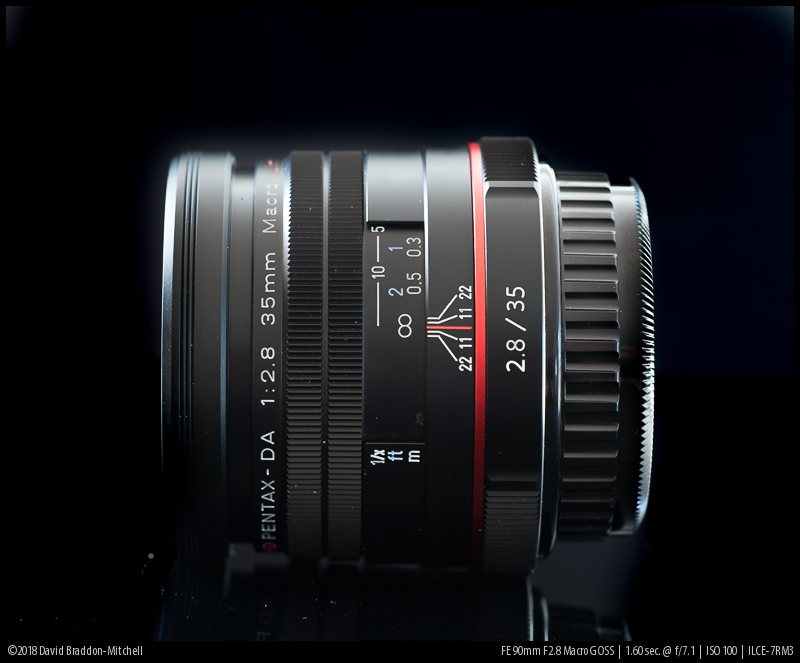
| Strengths | Weaknesses |
|
|
Amazon.com | B&H |Ebay (affiliate Links)
Ultrawide Macro Lenses
Maybe there shouldn’t be a plural here. There’s only really one: The Laowa 15mm f4 macro. It lets you get really close (at 1:1 the subject will brush your front element) which can give you some really interesting perspectives that you can’t get with the usual focal lengths.
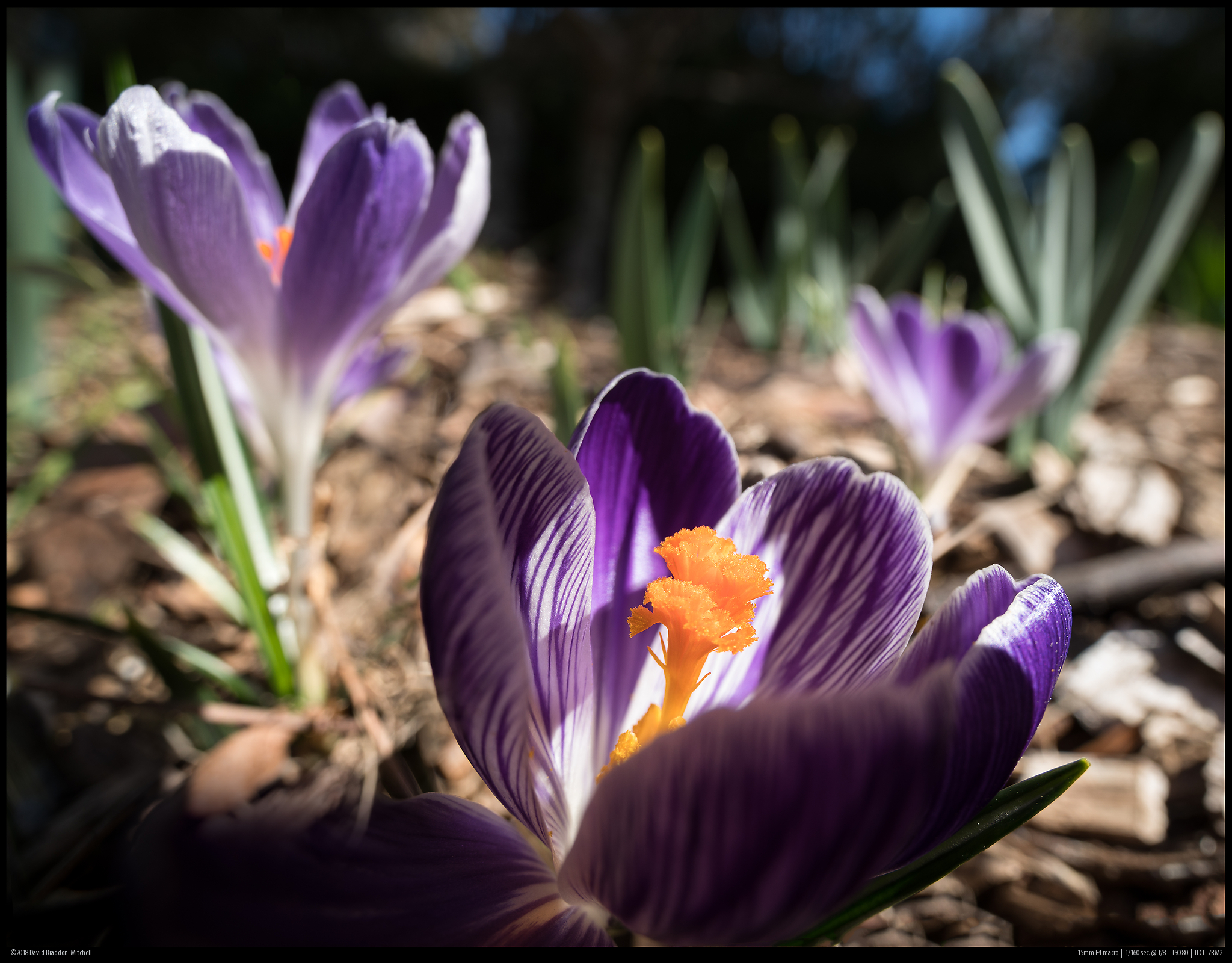
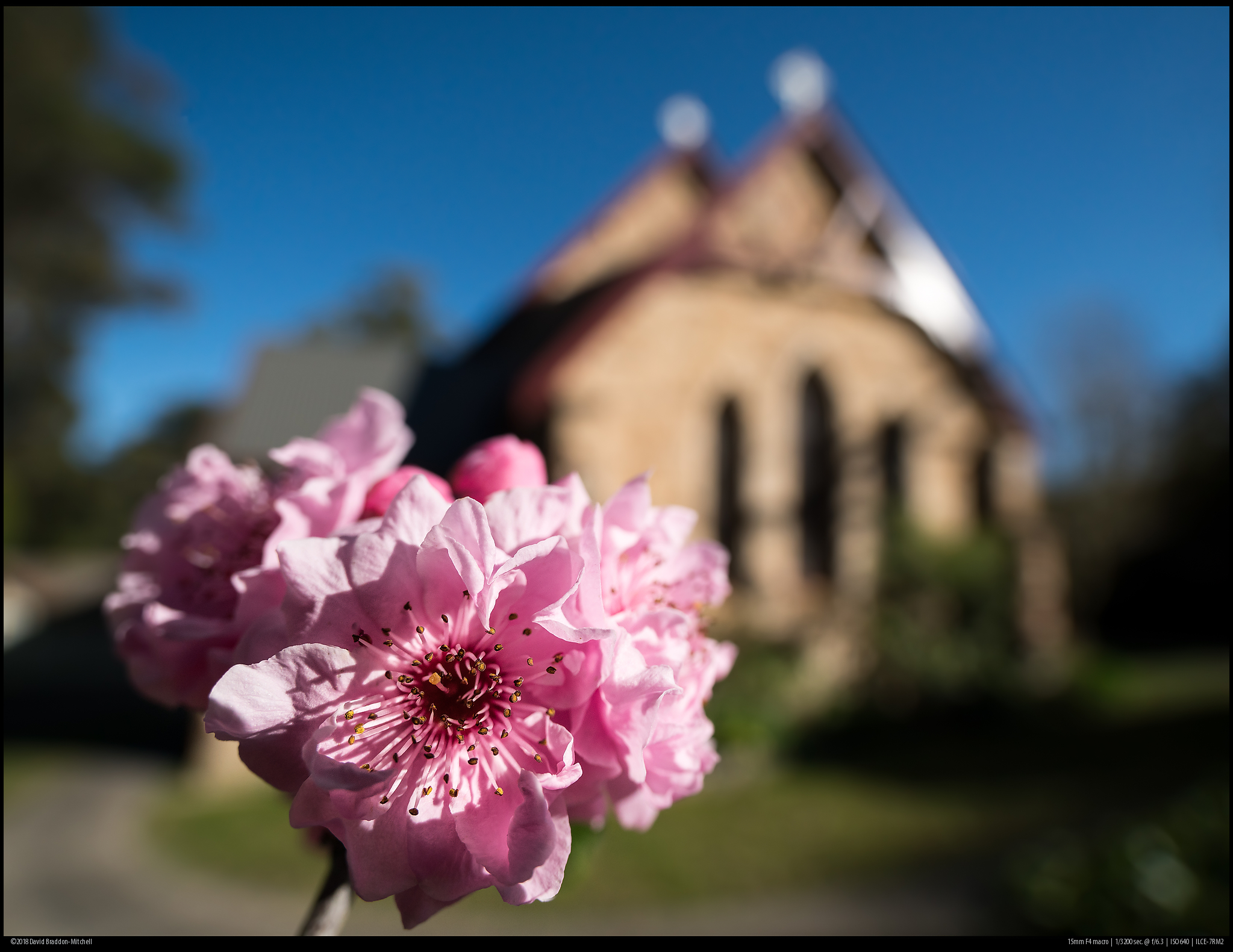
| Strengths | Weaknesses |
|
|
Amazon.com | B&H |Ebay (affiliate Links)
The Zeiss Classic Makro-Planar Lenses
We shouldn’t finish this roundup without saying something about the two Zeiss Classic (available rehoused in heavier but more sealed bodies as Zeiss Milvus) Makro-Planar lenses.
There is a 50mm f2 and an 100mm f2 version. Both only focus to 1:2, but are very sharp lenses and were legendary, state of the art, designs when they were first introduced many years ago.
They are still very sharp lenses with nice bokeh. But no longer head and shoulders above the competition, and the price is not low. The 50mm version is somewhat overshadowed by the CV 2/65 we review above: this lens is noticeably better than the classic Zeiss 50, which was in turn a better lens than the 50 macros of its day.
The Zeiss Makro-Planar 2/100 lens is super sharp, but suffers from a bit more longitudinal CA than we would ideally hope for nowadays. The Sony 90 is cheaper, a little sharper at macro distances, has less CA and focusses to 1:1. The new CV 110 will likely overshadow the Makro-Planar 100 for the lover of true manual focus, though obviously this remains to be seen.
All that being said, both are beautifully built and excellent optics, and are both good choices as general lenses in their focal lengths. If you can find one at a good price, lower than the competing lenses, and don’t mind adapting, they are still fine choices for someone not looking to focus closer than 1:2.
Closeup lenses and Tubes
If you only occasionally need to focus close, or if you are travelling and don’t have room for your macro lens, you can consider adapters that allow you to focus closer.
The two most well known kind are extension tubes, and close up lenses.
Extension tubes contain no glass. They are just tubes that go behind the lens, pushing it further out that it’s own helicoid can manage, thus making the lens focus closer.
Some people think that because they contain no glass, they must give better IQ that lens elements you add to the front of the lens (like so-called “close up filters”). This is not necessarily so. Extension tubes make the lens focus close. If the lens if already not performing at its best at its native close focus, pushing it out further to give close focus may not give good results at all. It’s not hard to tell. If your main lens is fantastic at its closest focus, you can probably add a short tube and it will still perform well. But if it’s already a bit ropey at minimum focussing distance, you may need a close up lens.
Close up lenses change the optics of the whole system, to allow focus at various distances governed by the focal length (usually expressed as a diopter rather than a distance) of the close up lens. Because they (for a fixed lens position) have the same focussing distance regardless of the lens focal length, they give more magnification with tele lenses than shorter ones (the distance is the same, so the longer the lens the more the magnification).
Why can they give better results than tubes, despite adding lens elements? Because they allow the main lens to be used at the setting it works best at. You can se the main lens to infinity, and the close up filter may make it focus much closer. Although the filter will introduce some aberrations, this is more than compensated for by the main lens working well, rather than at its own MFD setting, where it performs poorly.
All this, though, is assuming that you are you using a good quality two element achromatic filter. The cheap single element filters will produce colour errors, and poor sharpness outside the absolute centre.
Our basic recommendation: if your lens performs well at it’s current closest focus, try a tube. Otherwise use an achromatic two element close up lens. Also, for longer lenses the achromat may be a better idea for macro purposes, and for shorter ones a tube may give more magnification. You should also bear in mind that tubes reduce the amount of light at the sensor whereas front filters don’t, though the exposure tools on Sony cameras deal with this automatically.
One brief extra bit of information: if you divide 1 by the number of diopters of the achromat, you get the rough distance the combination will focus when the main lens is focussed at infinity. So a 1 diopter lens will focus at 1/1 = 1 metrs. A two diopter lens at 1/2 = .5 metre, .5 diopter lens at 2 metres and so on. If you focus the main lens closer, you’ll get a bit closer but not massively (you can find calculators online). This tell you why you get much more magnification with diopters on long lenses. A 200mm lens focussed at .5 metre gives a lot of magnification, whereas a 50mm lens usually has a native close focus that is a touch closer than that, and a wide-angle is grieving very little magnification focussed at .5 metre!
There is a lot more to be said about achromats, but that may have to wait for an article of its own.
The least bad tubes are ones you can get for Sony are the Kenko ones; they at least have good flocking so will not generate reflections like many others.
There are many good achromats around, but the Marumi 3 diopter and 5 diopter ones are affordable, decent, and come in useful sizes. Probably the best are the Raynox DCR-5320PRO, which comes as a 2 diopter 2 element lens, a 3 diopter 3 element lens, and can be stacked to give 5 diopters. But they are only available in 72mm, are large and heavy, and expensive.
Some affiliate links for tubes and achromats:
Kenko Extension Tubes: BHPhotoVideo
Marumi +3 Achromat: Amazon
Marumi +5 Achromat: Amazon
Conclusion
As usual there is no best solution for all needs. The Sony G 2.8/90 will probably cover the widest range of requirements but in the ends you should check what is actually important to you. Phillip for example sold his G 2.8/90 and went for the Voigtlander 2/65 instead because, while he appreciates to be able to focus a bit closer, his focus isn’t on macro but on other applications. David on the other hand has to explain why two shelves of a dry cabinet are devoted to macro gear.
We hope to have helped you with your decision. If any questions remain don’t hesitate to leave us a comment.
Support Us
Did you find this article useful or just liked reading it? Treat us to a coffee!
![]()
![]()
![]() via Paypal
via Paypal
This site contains affiliate links. If you make a purchase using any of the links marked as affiliate links, I may receive a small commission at no additional cost to you. This helps support the creation of future content.
The Team
Latest posts by The Team (see all)
- Sony FE Lenses: The honest Guide for the A7/A9/A1 Series - March 18, 2025
- Guide to best Sony E-Mount 35mm Lenses for A7/A9/A1 series - March 8, 2025
- Guide to the best Portrait Lenses – Sony A7/A9/A1 series - February 22, 2025

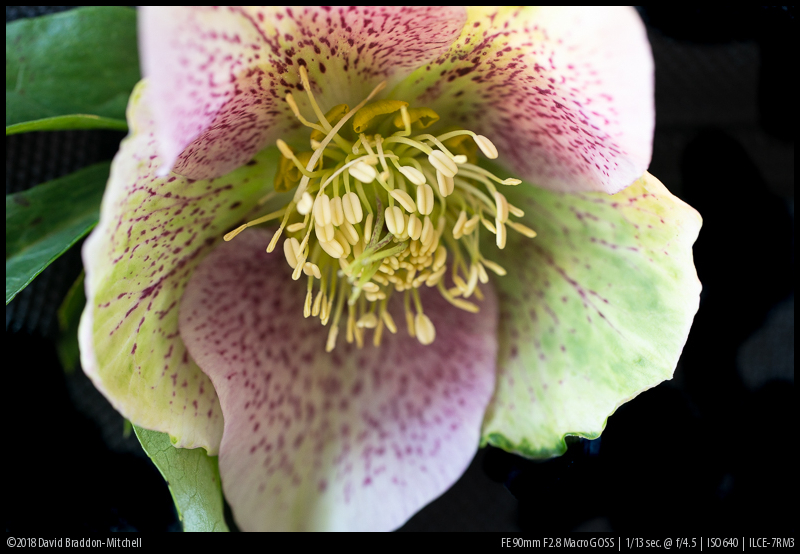


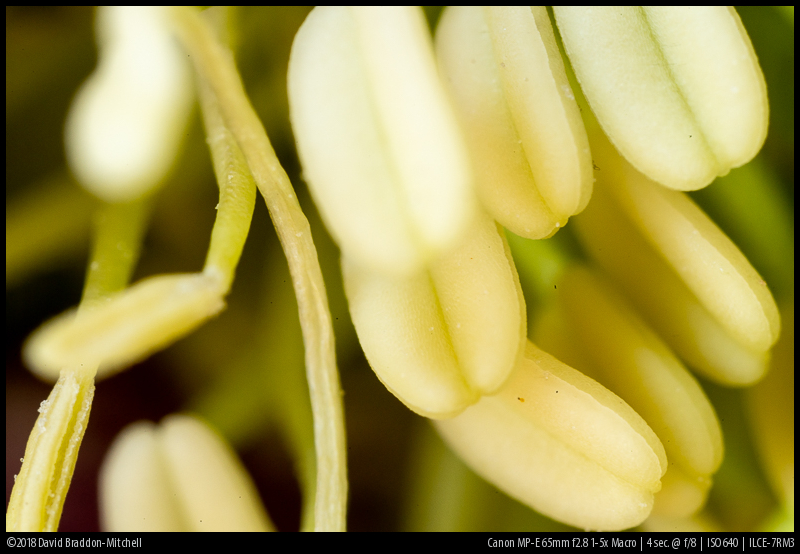

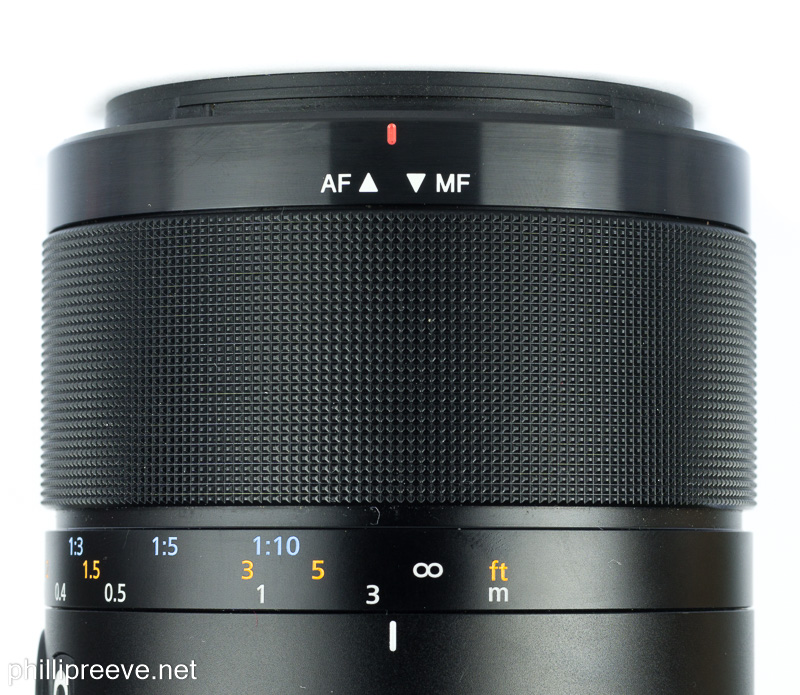
I would have mentioned also the Minolta AF 100mm F2.8 Macro as a ‘cheap’ alternative for the Sony G 2.8/90.
Can be used for landscape, portraits (with sony’s AF adapter), macro.
And also there is a brand new Mitakon 20mm f/2 4.5X Super Macro Lens for 200$.
We haven’t used the old Minolta/Sony A and we usually only mention lenses we have some experience with; people we trust say it’s good, but that the older Canon one is just as cheap and a touch better. But none of us can vouch for that directly! Certainly, though, the latest incarnation of metabones works as well as the A mount adapters, so there’s no real advantage to using A mount over Canon EF mount.
I just added the Minolta.
I wasn‘t aware of the Mitakon. Seems to be an interesting lens.
Phillip, thank you for this article.
I am now recognizing an advantage of using an adapted DSLR lens via an LE-EA4 vs. a native E-mount lens: the preset diaphragm.
Question for you is focusing wide open vs. stopped down. Generally my nature closeups are done at f16. At this aperture DOF compromises focus precision. Mirrorless lenses are focused stopped down whereas DSLR lenses have aperture preset and are focused wide open.
When working from a tripod it’s certainly possible to focus wide open, then reset aperture, shutter speed and ISO for final result. Yet when in the field, where time counts, puffs of wind reposition flowers, and bugs fly off, this fails. Even more complicated when adding flash.
My lens choices for my a7iii are a Minolta Maxxum 100mm f2.8 adapted with the LA-EA4 and a Micro Nikkor 55mm f3.5 (family favorite in the Nikon F – Nikkormat era). (Until recently I also used a Zeiss Touit 2.8/50 on APS-C Sony.)
With the LA-EA4, the Minolta meters and focuses wide open, then stops down when shutter is released. This seems to be advantageous.
In this example created yesterday in my garden – https://photos.app.goo.gl/NYEzt2Sond1dBxMdA – exposure and manual focus with the Minolta were adjusted for the tiny image in rain drop using focus magnification w/ yellow peaking and zebra lines. Lens was preset to f/16 but focusing occurred at f/2.8. Image was reproduced at 1:1.5, then center cropped. Shadows (the stem) were recovered in Lr. I was unable to get a comparably accurate focus with the Micro Nikkor on manual Fotodiox adaptor, lacking diaphragm preset.
Your thoughts on focus precision with preset vs. stopped down lenses?
Thanks!
What is the issue with focusing wide open and then stopping down manually for such a static subject?
There are advantages to focusing wide open and stopped down. Here’s a trick: with native lenses if you turn off the Live View Display Setting Effect (page 9 of section2 on the A7RIII) the camera will display the image with the lens wide open, though it will stop down to auto focus and take the image. For macro I use manual focus. The trick is if you are in manual focus mode pressing the AF-ON button or half pressing the release will stop the lens down for a preview. This works even with the focus magnifier on. So you get the best of both ways without constantly opening and closing the aperture with the back wheel. Used with focus peaking you can quickly determine both the plane of focus (assuming it doesn’t shift stopped down) and the extent of depth of field (and maybe seeing the focus shift).
Just to draw a little more attention to my personal favorite: the Tamron AF 90mm f/2.8 SP Di (Canon version). Really thrilled with it, best ever price / performance ratio. Fairly lightweight, too. Forget about AF, but great for macro work, really nice for landscape work as well, no complaints about bokeh. Sharpness to my eyes is great corner to corner. Who needs the overpriced “Bokina” when you can have this?
Anyone have experience with the older non-Di version? Same SP 90mm F2.5 for A mount. That seems cheaper on the second hand market and since I won’t be using AF anyway I wonder if the optics are the same or comparable. Thanks.
Thanks.
Will be helpful to give 1:1 and 1:2 distances from the sensor.
Nde
I have the Laowa 2.8/25 2.5-5x Ultra Macro.
It is an interesting lens to say the least. I’ve managed a few good photos with it though. Both using a tripod and handheld (with flash). Here’s a couple of examples:
https://www.deviantart.com/jon-hill987/art/Hoverfly-755316820
https://www.deviantart.com/jon-hill987/art/Common-Green-Capsid-Lygocoris-pabulinus-02-752394258
The lack of EXIF is a pain, I’d like to be able to view back the f stop so I can learn from mistakes, but this is a minor gripe. It seems well enough built.
On another note, while not exactly macro, I have found for larger insects like butterflies and dragonflies my Sony FE 100-400mm f/4.5-5.6 GM OSS with 2x Teleconverter is far better than my Sony 50mm f/2.8 Macro. It can focus at just under a meter giving around a 1:1.3 with the teleconverter on, and 1:2.6 without.
Cheaper alternative to the Tokina is the Vivitar Series 1 version. Flare resistance is a little worse but in macro situations you should be able to work around this. I paid $150 for mine with the 1:1 adapter. It’s not always this cheap but it’s usually quite a bit cheaper than the Tokina version.
I have used the Tamron Adaptall-2 SP 90mm f2.5 (both 52b and 52bb variants) with superb results, the original 52b all metal and glass version still feels amazing to use even at pushing 40 years old.
Sharp enough to my eyes wide-open across the frame at landscape distances, and sharp as a macro. I managed to pick up a mint copy for just £35 and nothing will touch that value-wise. I may now be selling as just bought a Voigtlander 65mm f2 as it offers sunstars, better flare resistance and a nice ‘walk-around’ focal length as a do-it-all portrait, landscape and flower lens.
https://www.ephotozine.com/article/meike-85mm-f-2-8-macro-review-31461
I bought this lens on offer for € 200, after reading this article, it is also sold in e-mount, in my opinion, quality-price is fine
I read your articles since 2016, many thanks for your work
Never heard about that one but seems to be interesting. where did you get it for 200?
Thank you very much for your answer, I’m just passionate about photography, I wanted to help in your web of manual lens. I bought the lens in Aliexpress, on the special day, it is important to talk to the seller, and explain, that it is an art item, for this to be clear in customs
Another thought on extension tubes vs. close up lenses. Extension tubes require you to adjust your exposure for getting to 1:1, but close up lenses do not.
Also, the longer the focal length, the less useful extension tubes are and the more useful close up lenses become…and vise versa for shorter focal lengths.
We did mention the second point, but forgot to mention the first…cheers
no analysis about SONY FE100 GM Macro?
Analysis: It doesn’t exist.
I recently got my Bokina with good price thanks to you guys. Big thanks from my heart! I genarally liked its peformance, but what I didn’t expect was its enormous focus breathing. I used 100mm f2.8 usm EF lens before but I didn’t noticed this much. It is harder to compose but I finally got used to it. Thanks for the nice article, too
https://1drv.ms/u/s!ApChBCAABuR-hZUexcK_E2xQhiyyIQ
I’ve tested its centering issue with your method, and I’m quite happy with that.
A well balanced description of the FE 2,8/50 Macro. I love that lens since I have decided that this little electric AF motor is no problem to me.
Yes I’m very fond of it. It’s a go to lens for me if I’m doing multi day hikes and I want some macros on the way. Plenty sharp enough for landscape, very good macro, eye af works fine for informal snaps of my companions (though bokeh at portrait distance isn’t great) and a good basis for stitching to get wider images. And so light!
What is your opinion on the Zeiss Makro Planar 100mm f/2.8 T Lens for Contax/Yashica?
Do you know if it is 1:1 or 1:2?
Jannik owns one and likes it. It isn’t a great choice for 1:1 work though because it can’t maintain the good correction it has at longer distances.
If you already own one or can get one for a good price you should be able to get nice images out of it but I probably wouldn’t pay what is normally paid for it on ebay.
Thx. At the moment I see prices around 600€. (ebay.de) too much for too many compromises..
My recollection (haven’t seen one for ages) is that’s it not bad for macro but not good at all at longer distances. It will focus to infinity but doesn’t do well there. But that’s just a memory…
EDIT nope different c/y 100mm macro see next comment…
Oops what Phillip says is right. I was thinking of the S-Planar 100mm (and 60mm) C/Y lenses, which were macros optimized for close distances.
The Contax Carl Zeiss Makro-Planar T* 100mm f/2.8 is a huge lens on Sony A7II. It’s a 1:1 macro.
I prefer the Contax Carl Zeiss Makro-Planar T* 60mm C f/2.8 for the A7II, but it’s a 1:2 macro. It’s a small light lens.
Nevertheless the Contax Carl Zeiss Makro-Planar T* 100mm f/2.8 is a great lens, but it fits better to the Olympus OM-D E-M1X.
For macro photography I would recommend checking out this guy’s reviews:
https://www.closeuphotography.com/lenses/
He also has an excellent series of comparisons:
https://www.closeuphotography.com/lens-tests/
It is interesting to see that bellows lenses like the Canon 35mm f/2.8 MacroPhoto beat the MP-E 65mm in terms of image quality. Moreover, even very cheap microscope objectives thoroughly trounce the Canon MP-E 65mm’s resolution at 5x magnification.
Dunno about cheap ones, but yeah a reasonable plan or APO plan microscope objective will do better at 5x and you can get 10x with good results. But it takes a lot more work and DIY and the MPE gives you easy dial up from 1:1 to 5:1.
Sone day we may write more of a specialists guide to high mag, though good resources already exist. But for this article, a kind of beginners orientation, some of us thought that even the MPE was going too far…
Line scan lenses, scanner lenses, machine vision lenses, and inspection lenses routinely beat the MPE at less magnification such as 1:1 and 2:1.
For example in the 2:1 comparison test (https://www.closeuphotography.com/2x-lens-test) the MPE is the worst of the bunch, despite being the most expensive.
For each of the reviews of the lenses, he also provides the tubes and stuff necessary to get it mounted on his E-mount Sony a6300. It’s true that it’s more work, but studio macro work at 1:1 and above requires a lot of work anyway. The tubes and adapters to mount these lenses are usually very cheap on eBay.
Sure they do; and I use an adapted machine vision lens adapted myself at time; as well as microscope objectives on a tube lens.
But for this article we were interested in lenses for beginners, and even though the work required to use these is not great, it would be think intimidate beginners, so our coverage was restricted to all in one solutions. We even wondered whether the consider high mag macro at all, given that even using something like the MPE its maybe out of the scope of beginners.
We might do a more advanced article eventually, but it would be me doing it since I have more interest in this kind of thing, but there are already lots of great sites out there covering this (the one you mention is one of them) and I’m not sure we’d have much to add.
A competent overview of the normally underestimated, but highly versatile Olympus OM system close-up and macro equipment can by found via the link
http://www.alanwood.net/photography/olympus/#macro
Some of the OM Zuiko legacy macro gems (e.g. Zuiko Auto-Macro Lens 135mm f/4.5 attached to Telescopic Auto Tube 65–116) are still available at the used market for modest prizes. The Zuiko Auto-1:1 Macro Lens 80mm f/4 can be recommended for copying slides, BW negatives and so on.
I use most of them on a Sony A7r and Olympus MFT cameras.
How about enlarging lenses, eg Fuji Ex, Nikkor, Rokkor CE?
Today it’s easy to find an FE adapter with some focusing, plus a tube to give a limited range macro.
I had good results a couple of years ago with Fuji EX and ES.
Have you tried?
Danny
Sure: I have a collection of Nikkor and Schneider enlarging lenses I sometimes use. (I think I mentioned this possibility in passing)
But, as I’ve said to others, the article was meant to cover all in one solutions for beginners.
Thanks, David,
I’d be interested in how you think the best of these 6 element lenses (usually) compare for
1: macro use as in your very good review
2; flat copying of analog prints, slides, etc where bokeh won’t matter but resolution, contrast and CA across the field are crucial.
danny
For macro use the Componon-S 50mm is very good and the best enlarger lens I have (there’s a guy in Spain who sells adapters for it to be reverse mounted on M42 helicoids) giving nice results from 1:1 up to twice life-size if you can be bothered. I don’t however think it’s better than the MPE, perhaps less corner resolution, and less convenient. I haven’t tried any of the really high end one like the APO-Componons. But it can be got at a good price, and for those who don’t mind the DIY hassle it’s a good choice. Bokeh is not the strong point: but at high mag I often use f2.8 and focus stack; or sometimes focus stack a couple of stops down and blend in an f2.8 image for the bokeh.
For copying I couldn’t tell you. When I was digitising my slides I scanned them, and on the few occasions I have copied prints they have been large enough that a normal flat field macro lens does the job. You would have to imagine, though, that a decent ENL lens would be pretty flat field, given what it’s designed for. But imagination is not the same as testing~
The Zeiss C/Y Makro-Planar 60 mm/2.8 is also worth mentioning if you can find it at a good price.
And I can vouch for the Minolta AF 100/2.8. Decently sharp, nice colors and works good as an allround lens.
What about the Canon FD 100mm f4 Macro?
Is it any good?
its slow and only 1:2 but probably a bargain?
According to a Color Foto Test from 1980/81 one of the best 100mm Macro Tele. Better than Leitz Elmarit-R, as good as Nikon, Minolta is sharper in the edges.
Bought it in the Canon FD era when I was using the T90.
Great post, didn’t know about the pentax DA.
I tried the Bokina and it is an excellent lens, but the Tamron 90mm is as sharp and a lot cheaper. The Bokina has a smoother bokeh, but not that much.
I love my Minolta 50mm macro, excellent lens. The FE90 is focusing way too slow for my taste, for a native FE lens, but very sharp. It’s focusing even slower than the Canon 100mm L with the MC11. If one’s got the money and needs the reach, the Minolta 200mm F4 can’t be beaten. All time favourite’s the CV 125, though, and it’s hard to imagine that CV can beat that with the 110mm, but we’ll have to see. I’d love to see Sony come up with a fast focusing 150mm macro I could use underwater, but that market’s probably too small.
Is the Laowa 15mm f4 lens in E mount good for astro photography as well? How would it perform when compared to Sony 16-35 f4 ZA and Rokinon 14mm f2.8?
Thanks.
No it doesn’t perform well at infity and is also slow for astro photography.
Indeed, the Tamron AF 90mm/F2.8 SP Di Macro (Version 272E) is an outstanding performer and very versatile. Most probably the best what you can get for little money. I’ve got the Minolta/Sony A-mount version already for my Sony A850 and use it nowadays via the LA-EA4 adapter on the Sony A7R II. It covers macro up to 1:1 and can also be used for portraits (very appealing and smooth bokeh) and general or landscape shooting. I didn’t find any weak point up to now and would never change it to any other lens, not even to the so much appraised Sony FE 90mm/F2.8 macro lens. I doubt that you would see any difference in real life photography, maybe not even in “pixel-peeping” mode.
Moreover, the 55 mm filter thread of the Tamron fits perfectly to the Minolta R-1200 macro ring flash which is the only one which works perfectly in TTL-mode on the Sony Alphas. The Sony lens with 62 mm filter thread is therefore definitely second choice.
Hi Thomas, I see you have the macro 1200 flash
and use it with a7r2. I also have this flash since it came on the market but have connected to my Sony A7r3 for fear of overloading the the trigger.
How does it work ?
Cheers, Les Sergeant.
Could the Zeiss 85/4 Tele-Tessar be made to work for macro?
My limited macro efforts involve only static objects (mineral specimens and slide copying). I’ve been using a Nikon 105mm f/2.8 VR macro with a dumb adapter to an A7R III, but the combination is rather large and clumsy. The little Zeiss lens is quite sharp–might it also be (nearly) as sharp as dedicated macro lens at 1:1 with the appropriate tubes?
Hi, I would like a macro lens to be used only for the duplication of negatives on a stand … what do you recommend? thank you
I think the Sony 2.8/50 is ideal for that. It’s relatively cheap, and goes to 1:1 which you need for neg duplication, and much sharper at 1:1 than classic ones. It also works with the Nikon ES-1 slide duplicator (or the more convenient but much pricier ES-2) (you may need to make or buy a frame for negatives).
I’d certainly recommend some kind of duplicator arrangement.
Thank you for your kind reply…I have sony 55/1.8, Loxia 21/2.8 and 85/2.4…would it be possible to use one of these with an extension tube? If yes what tube? Thanks
The Loxia 85mm 2.4 works very well with an extension tube, have a look at this article.
… in the end I decided to take a macro lens … now my choice is between the sony 50 / 2.8 macro and the sigma 70 / 2.8 macro … what do you think about the duplication of old negatives? thank you
Hi just a bit of advice from your experience – I have paid & been waiting for this mythical Voigtlander macro 110 & time just passes by without any news
The thought of the macro interested me & the focal length 110 sits nicely with what I would want – but my priority is going to be landscape & not insect eyeballs
I am becoming fed up of waiting & am reconsidering my choice & looking again at the loxia 85mm. It seemed to me – in the 65mm voigtlander review ( Which I read to gain an idea of a lense such as the 110 might present ) – that the images don’t hold up too well at smaller apertures ( in spite of the sharpness of the lens that was observed during your review ) – I only found a few ‘distance’ images & they showed quite significant softening & so – is a macro lens not for me
Also – the orchid photo in particular !!!! The wide aperture was significantly less sharp than at 5.6 / 8.0
As I am probably going to prioritise middle distance to further distance images & I wanted the longer focal length to pull in information – & bearing in mind that this 110 lens doesn’t appear to exist – do you think there is an argument that the loxia is better suited to what I want anyway
Would you stick out until 2019 with £850+ sat in somebody else’s account – as I can have the loxia tomorrow !!!
I would have been very interested in the macro – but my other lenses don’t have bad minimum focus distances & I fed up
Thanks
CB
Personally I prefer the rendering of the Loxia 85mm 2.4 over that of the Voigtlander 65mm 2.0, but obviously I have no idea yet how it compares to the 110mm 2.5.
For me adding an extenstion tube to the Loxia 85 is all I need to get closer, but I am not a regular macro shooter.
Thanks for getting back
With only the CV 65 to go off – it seems to me that the loxia affords greater clarity & resolution as it is stopped down & that is really where my interest lies !!! I don’t think the 110 can be optically much better than the 65
I have the loxia 21mm 2.8 & love it !!! Particularly the range of f stop sharpness & the colour management !!
I would love the longer focal length of the 110 – do you think it is that significant 110 / 85 – my most treasured old lens was a 75 – 150 zoom & I always found myself cropping & operationing at about midway !!!
However – that was before lightroom & all in camera !!! With 42mp & modern lenses – a bit of cropping for intimacy / deeper into view into the subject won’t really hurt !!
Thanks again for all you guys do – all the best
C
It’s a shame this has happened – I think I ordered & paid in July – but there doesn’t seem to be an end to it & no information or updates
Ce la vie !!! ?
I would really like a 75-150mm 4.0 zoom in the Loxia lineup…
It’s a brill lens & such a useful range – I have cleaned it up & bought a Pentax k – Sony mounting adapter & am having a play !!!!
You can see its age though !!!! Still it’s fun
It’s also still got the uv filter that I bought – 1979 !!!!!
This lens – a 500mm mirror – a 50mm !!!! & Pentax ME !!!
500mm lens weighing in at less than 450g – I liked the doughnut bokeh!!
Thanks again !!!
Phillip, thanks for such a useful review. But have you considered value of preset diaphragm for low light macro?
Sometimes something which should be obvious is so close to our eyes we embarrassingly look right past.
Rangefinder cameras were unsuited for macro. We carried a measuring stick.
Leica Visoflex on an M3 solved that problem, but focusing through our final stopped down aperture was inaccurate.
SLRs of the 1960s brought us the preset diaphragm, allowing us to set exposure, then compose and focus wide open, lens stopping down instantly when shutter released.
With mirrorless we are back to focusing stopped down. In macro this is problematic. It’s impossible when in low light or when using flash, for instance to arrest motion of wild flowers shaking in alpine winds.
When I use my Minolta Maxxum 100mm f2.8 macro on an LA-EA4 I get the preset diaphragm built into this lens, however when using a native E-mount macro, or a vintage Micro Nikkor 3.5/55 on a Vello manual adapter, there is no preset.
Additionally, preset diaphragms allow metering wide open. In this example, taken this week at my home with the Minolta + LA-EA4 mounted on an a7iii, I needed f/16 for DOF, needed to expose for highlights within the micro image in droplet. Used tripod, yellow peaking high, 2nd level focus magnification. To avoid blowing highlights used zebra lines on clouds within micro image. Here is original from camera and crop after bringing up shadows in Lr: -https://photos.app.goo.gl/ju3mpWb8mUUk1M5k8 – I tried to record this image using lenses lacking preset diaphragm and it was too difficult, failed repeatedly.
Final step should be focusing. To focus first, and then reseting exposure to final stopped down setting, risks loosing precise focus.
Thoughts?
For some scenarios sure.
For situations like these you might want to uncheck “Live View Display: Setting Effect”.
This is explained in detail here.
If I am not working with flash I greatly prefer the WYSIWYG viewfinder as I will always see the actual depth of field in the viewfinder.
I don’t have many macro lenses, but i REALLY enjoy the Canon new FD (i call it nFD) 50mm f3.5 from the cheap budget range. It’s somewhat long, because the lens elements are so deeply recessed. But that gives it better flare resistance, protection, etc.
To counter the size, it’s VERY light in weight (~220g, like plasticy nFD lenses in general) and a real JOY to use! Almost the same size and weight as the Olympus 60mm f2.8 for m4/3. It’s a beautiful lens that produces pleasantly sharp pictures with great contrast and vividness. I’d compare the color punch to something like Pentax or Minolta MD 35-70mm f3.5 1:4 macro levels.
f32.0 is quite unusable, but otherwise great and very nice wide open too! The focusing is perfectly smooth and precise, like in general with nFD lenses and bokeh is nice. It just feels so nice. One downside is the very noticeable focus breathing. Anyways. Maybe the bigger size with the perfect focusing and light weight makes it so great. And the pictures speak for themselves, time and time again.
It’s quite a budget lens around 50-100€, but great stuff! Surely something like the 90mm+ range is more versatile in the field, yet a nice 50mm macro always has it’s place aswell. I use this lens on crop sensor cameras (aps-c 1,5x and m4/3 2x), it’s really nice on NEX especially with the great grip.
Just sold one Tamron macro 90mm f2.5 (52B), because it was simply way too heavy! Superb build quality, one hell of a lens but heavy! Noticed i’m just not taking it with me to the field, and that’s what matters. The blue dot sensor reflection was killing it for me also. Use the lens hood and recommend the 1:1 (2x) extension.
There you go. Happy shooting! 🙂
My Macros of choice are the Oly 50/3.5, the Sony 90/2.8. The one that is missing here is the Minolta Rokkor 100/4. With or without the Macro Tube it’s a remarkable lens, even wide open. I used it for over a year until I got the Sony.
The website link I listed is for the Minolta images I have on Flickr.
I used a MD 4/100 for a while on the Sony Nex series and it is a solid performer for sure but in comparison with other macros it didn’t stand out enough that I felt a need to include it here.
I did not see mention of the Minolta 200mm F4 APO Tele Macro – a Minolta A-mount very similar to the superb Nikon 200/4.0 AF micro nikkor which I have used as my main macro lens for many subjects for 25 years. The Minolta is hardly ever seen here in the USA for some reason but they are available from Asian sellers. I use mine on the LA EA3 – it is not too heavy and has a rotating tripod collar. The Nikon version has a better tripod collar and is also an excellent lens to use on Sony although automation of the diaphragm requires one of the special Nikon to e-mount automatic adapters.
Interestingly both of these lenses seem to have similar or identical optical formulations and both were released around the same era.
The Sigma 150/2.8 are also excellent.
I also have a large selection of scientific macro lenses and microscope lenses ( zeiss luminars, Nikon macro nikkors, and Mitutoyo LWD APO’s ) for higher magnification projects
Hello there!
Thanks for all the great reviews and wonderful images that you publish in your site.
Question: considering a very limited budget I can afford one of the following combos:
A.- Sony A7Rii + Sony FE 50 mm 2.8 Macro
or
B.- Sony A7ii + Sony FE 90 mm 2.8 Macro
Which option you prefer?
Thanks!!!
If you plan to have only one lens in your kit, then I’d get the 50. It’s moe versatile than the 90 even though it has some drawbacks ( worse AF, busy bokeh in portrait distances though fine at macro). It’s also much lighter. And you could afford another lens sooner. Unless you love resolution I might also be tempted by A73 over A7r2. Many little niggles were sorted out.
Tried any medium format macro on Sony yet?
The medium format lenses (especially older oens) are not exactly designed for high pixel densities and therefore might not be the best option.
Hi Phillip
Can you please advise if the MINOLTA AF 100MM F2.8 MACRO LENS 100/2.8 is compatible with Sony a7rII ? does it need an adapter or no.
Thank you very much and best regards
Needs the LA-EA4 adapter.
Hi Guys! Thanks for this very useful post on Macro.
I am having the usual Sony G90 vs 110 APO. I can’t really decide which one to go for. For the time being, I got an a6300 (with plans to move towards an a7xxx in the future). I m a total newbie, and the lack of only-manual, no OSS kinda puts me off. My primary use of the lens will be 1:1 macro. Then, as the only other lens that I ve got is the 16-50mm KIT lens, I intend to use the macro also for some landscape photography (judging from samples, both the G90 and the 110 APO are quite usable)
Personally, I m slightly biased to go with the 110APO, mostly due to better glass and build quality. For it’s price, it seems like getting Zeiss-level qualities for half price! I like that potential in getting sharper, superior shots.
My concern with this lens: No AF. I am a total newbie. Will I be able to pickup with manual shooting in a reasonable period of time? Doesn’t sound too easy. I got a tripod that I can use, but I wouldn’t like to miss ‘point and shoot’ (that the G90 offers). Because I don’t think I can go handheld with the 110APO (no IBIS on the a6300 either…). You do mention that for Macro photography, AF isn’t really an advantage and I think I get why. But also as you mention, the G90 doesn’t impose a restriction in this respect, as the focus lock button allows it to work as a MF lens would.
Then, it’s the thing about video. I would like to be able to shot short clips (either in macro or landscape using a gimbal). And in my mind, AF is essential whilst shooting video. Not only of the clicking sound the aperture ring will make when I have to adjust, but mostly because during adjustment, there will be plenty of vibration (unless I m shooting on a fixed position from tripod – otherwise it would be a pain..)
One thing I don’t like about either lens – is the lack of proper weather-proofing. The G90 has some dust/moisture resistance (which is debatable, as there is no gasket). The 110 APO claims none. I can’t get why – especially for a macro lens – when you ll spend time in a forest doesn’t necessitate the need for proper sealing. But given current circumstances, there seems to be no choice on this, as for serious macro, one has to chose one of the two.
Then, there’s the ‘copy’ issue – mostly affecting the Sony. Will I get a decent copy? If not, how will I know given the fact that I m no expert? I am in no position of making a return claim, if somehow I ended up with a bad copy of the lens.
Apologies for long thread, it’s just that I m in such a dilemma regarding those two. I know that overall, both are great lenses and I ll be happy with either. It’s just that I would like to get exactly what suits *me* best and that I won’t regret at a later stage. Besides, I ll be only getting one macro lens (which means spending a monthly salary just for that…) Can’t afford to have both :/
Other than that, I can see that the 110APO is still rolling. It would be nice to have a direct comparison between the two. One more question please – in 1:1 (life-size) shooting, which of the two is the sharpest? Is there really that much difference?
Cheers!
Still happy with my CV110 but I think in your case I would go for the Sony. At 1:1 it is actually a littler sharper than the Voigtlander and has no issues with straight aperture blades. AF and OSS are in your case good arguments for it while there aren’t that many for the Voigtlander beyond image quality and while the CV110 is a little better in that regard (at longer distances) this difference probably won’t be noticeable to most of those which could see your work.
Cheers for input Phillip!
When you say that the G90 is sharper at 1:1 – do you mean at wide open and sharpness throughout the entire image (center + corners)? (although I d guess that in macro shooting we are mostly concerned with ‘center’). As for the non-macro part, from what I ve read the CV110 gains a slight(?) advantage over at infinity (as demonstrated by landscape shots).
As a novice, I did spend some time with the ‘AF peaking’ feature on my a6300 – which looks pretty handy. Although I was worried about the lack of AF on the CV110, it doesn’t seem too difficult shooting in manual mode.
Other things in my mind include build quality (+CV110), and lack of weather resistance for both. Sony claims ‘dust/moisture’ resistance (for which I m not convinced as you say!) as although it doesn’t externally extend, the buttons on the lens body could be it’s achilles heel. The CV110 could have issues with dust/dirt build up in the long term (but it’s otherwise a solid made lens).
Video shooting – as I do occasionally like to shoot short clips (usually at macro range). Sony should have the upper hand here, right? (AF, OSS essential)
Yes if you ignore AF, the CV has the advantage from 1:4 onwards.
And at 1:1 and 1:2 the Sony is better at every point in the field (especially in contrast) at all apertures – when you are focussed on that position. I haven’t tested it’s field flatness, as I don’t make macro images of 2D objects.
Copy variance is something to be aware of with the Sony so make sure you buy from somewhere you can return it. My first copy had huge tilt, with one side noticeably worse at all apertures – and in geneneral it seems to suffer this way. But when you get a good copy it doesn’t seem to go out of alignment (according to Toger Cicala)
Thank you David!
With sharpness/contrast considerations (at 1:1) out of the way, I leaning towards the Sony. I m just trying to figure what my working distance would be like. On a FF body 1:1 is achieved at 28cm. On my a6300, the effective focal length would be 135mm – but at what distance do I need to get to for 1:1?
My only other concern for the Sony was the build quality. What I gathered (mostly from Amazon reviews…) is that despite mostly being made from plastic, there are no major issues with it over the long term. I do appreciate the more quality feeling you get from the 110APO, but as long as it works, I guess that’s not too important. I mean, OK, it’s ‘only’ a $1000 lens, but it should last for a long while! (obviously provided that it’s well taken cared off e.g. not dropped, not used in pouring rain or anything).
Thanks for you valuable feedback on my queries!
Hello Team! Do you know if the strong copy to copy variation of Sony 90 f2.8 is still live in 2019? Thank you so much
Copy variation (according to Roger Cicala) is something which doesn’t change because to combat it it needs to be addressed from the design stage on.
https://www.opticallimits.com/canon_eos_ff/1060-laowa100f28
Laowa just released their 100mm f/2.8 2:1(2x magnification ratio) macro CA-Dreamer “APO” lens. OpticalLimits tested it and the results are pretty impressive. Of course, the results can vary from copy to copy and it is not the test at infinity.
Funny thing is each version of the lens has different aperture blades: Sony 13, Canon 9, Nikon 7. I guess it is about the reliability of the aperture control; the Sony doesn’t need it and the Canon is electronically controlled, and the Nikon is mechanically controlled.
If you are interested, please test it. Thanks.
We are going to review it.
The higher the number of blades the more friction and the more time it takes to open/close the diapraghm.
Pentax/Nikon still have a mechanical spring aperture, therefore only 7 blades.
Canon uses an electronical one, therefore 9.
Sony is full manual, therefore 13.
That’s so nice to hear.
So, basically my initial thought was plausible about the aperture blades.
The MTF charts from Laowa official web page shows that the lens is corrected at its best for 1:1(at least close to 1:1). It seems like it would be better using floating lens elements for even sharpness at every focus distances, but I guess there might be some sharpness advantage at specific focus point when using whole group focusing system.
https://www.venuslens.net/product/laowa-100mm-f-2-8-2x-macro-apo/
You can be sure that it uses floating elements, otherwise infinity performance would be much much worse. But even with floating elements any lens will perform best at one magnification.
http://www.northlight-images.co.uk/laowa-100mm-f2-8_2x-macro-review/
It’s hard to tell, but I think you are right about the floating element of this lens, judging by its gap difference between front and rear elements position of either end of the focus limit.
Thanks for the further explanation.
I bought the retail version of Laowa 100 2.8 by myself from a Chinese seller. It definitely uses floating elements. The front element move much longer than the rear element. It does NOT work with latest (V1.26) firmware MC-11 adapter with my A7m3, but kind of work with latest (V3.2) firmware Metabones V adapter on the green(blue light) mode. Its aperture is not automatically opened up when the camera is turning on, but the aperture preview function can fix the problem. Other than that, its aperture control, auto exposure and EXIF transmission is okay. I’ve tried the advanced mode(red light). but it was a total disaster.
https://1drv.ms/f/s!ApChBCAABuR-hoRBg22OPxEprLhwCQ
Here is my initial testing of the lens. It was tested with A4 sized MTFmapper lens grid chart, so its magnificaion is about 1:8.15. The Sony 90 2.8 is clearly better at F2.8, but The Laowa 100 2.8 catches up at F4.0. Both lenses produce softer images from F11. Overall I’m pretty impressed by the Laowa’s sharpness.
hello , i am between tokina 90 2.5 and olympus zuiko 90 2
the price is almost the same . i need a very good ( sharp & contrasty) lens for macro and landscape . which one would you suggest ?
At same price: Olympus with little hesitation.
Is olympus better at macro and landscape ?
I find tokina to be good at macro and very good at far away subjects …
why you hesitate ? 🙂
Everybody likes the Olympus OM Zuiko Auto-Macro 1:2/90 mm. I like it, too, but I think, there is a lot of hype about this lens.
I don’t have the Tokina 🙁
For macro there are better options than the Olympus OM Zuiko Auto-Macro 1:2/90 mm. I have compared it with my Nikon 2.8/105mm Ais. The Nikon gives you more details than the Zuiko. So I would go for the Tokina AT-X 90mm f2.5.
You wrote “it adapts well with the MC-11” regarding Sigma 150mm f2,8 macro. Does that include autofocus/stabilization as well ?
Hi,
Is it possible to use a closeup lens on a Macro lens ? (I have a Sony 90mm).
My goal would be to have 2.0x or 2.5x ratio. Or focus distance become too short ?
Regards
(and thanks for your great article)
Ludo
You could, and you could also use extension tubes – or both. Sure the distances become very short, but that’s a fact of life with 2x magnification
Unless you are using a 150-200mm macro lens with a 2x Teleconverter, that keeps working distance convenient but comes with other caveats obviously.
I was lucky enough to find a Minolta MD APO 100-500 mm f 8 at a very decent price.
This lens has a minimum focus distance of 2.4-2.5 meters which is pretty good at 500 mm. Depth of field is reduced by 500 mm fl but increased by f 8. It is of course quite heavy (2.08 kgs) and may require a tripod in most cases. It gives beautiful pictures with no CA.
My favourite macro photograper is Alberto Ghizzi Panizza. He was Nikon’s ambassador for the D850. He is famous for his dragonfly captures.
https://www.juzaphoto.com/me.php?p=&pg=248366&l=en
When you check out his galleries, than you can see that he has many different lenses in use.
Hi and thank you for your post on macro’s! What would be your recommendation in my use case below.
I would like to digitize some photos with my Sony A7M3 on a camera stand, instead of a scanner (see https://www.damuseful.com/collections/all-products/products/digitizing-your-photographs-pdf).
The author recommends the Sony 50 mm macro but “also tested the 90mm macro, which is a more modern lens. It has excellent optics, and a 90mm is a better general use macro. But I found both the working distance and the size of the lens less optimal for 35mm film scanning” (https://thedambook.com/dyp/cameras/). (Note that I will not scan 35 mm film, only old printed photos from different sizes.)
According to reviews my only lens, the 55 mm Zeis prime lens (Sony SEL55F18Z) is better than the 50 mm macro for general use. On the other hand I’m at the moment also researching a portrait lens.
So should I keep my 55 mm prime lens for general use as well as photoreproduction (although not ideal for it), and buy a 70mm portait lens? Or buy the 90 mm macro for general, portrait and photoreproduction use?
My main requirements are (1) sharpness and (2) autofocus (except for photoreproduction, where manual focus is OK)
Thanks!
Hi Paul,
I would in any case keep the 1.8/55.
I don’t know how large your prints are but since they usually have a rather limited resolution a cropped image with the ZA55 might be enough to extract all the resolution there is. Here I would simply experiment with the smallest print size you are interested in. If you feel limited by then lens then I would probably buy a used Sony 2.8/50 Macro for around $350 since working with a longer lens could be indeed cumbersome since you will find it hard to get far enough from your prints. Another way would be to adapt for example a cheap Olympus OM 3.5/50 Macro, your application play to its strengths.
Using a macro both for macro and portrait can work well but unless you plan to do some macro in nature I would buy buy a FE 1.8/85 or Samyang 1.4/85 which supplements your 1.8/55 well.
Many thanks for your recommendations Phillip!
These are family pictures from 1900 on, ranging from 3,5 x 4,5 cm to 8 x 8 cm to 16,5 x 22 cm and sometimes more. Once digitized I intend to restore them with Lightroom and Photoshop.
I will experiment with the 1.8/55 as you suggest, but also try the Olympus OM Zuiko Auto-Macro 50mm 1:3.5 with shorter focusing distance for small prints (great prices indeed on eBay.de).
The Sony FE 1.8/85 is actually the portrait lens I was considering but it’s expensive, so I’ll take a look at the Samyang.
Great guide to adapters also, and great site overall.
Would you say a Novoflex adapter is overkill in my particular case?
Thanks again,
Paul
for that application a Novoflex is probably overkill. K&Ms usually work well enough for a fifth the price.
Hoping someone can provide some insight or direction for my situation. I have some Pentax equipment that I would like to use with my Sony A7ii to copy 35mm negatives and slides.
I currently have:
Pentax A 50mm f2.8 macro.
Pentax Bellows A
Sony A7II and the PK to Nex lens adapter.
The minimum depth for the bellows is 25mm when tightened all the way. Which would create a 1:1 magnification for a Pentax Camera. However, using the Sony and the lens adapter, I think, it adds another 27mm making the minimum effective tube length 52mm and producing a magnification of 1.54. This is to much for the bellows slide copy system. Any ideas or thoughts as to how I could reduce the magnification? I couldn’t find a ‘bellows nex-pk’ adapter’ that would be 27mm shorter than the standard nex-pk lens adapter.
Short of removing the mount from the adapter, getting a machine shop to shorten the tube, and reattaching I can’t think of a solution.
Hi David, did you ever review the 110mm Voigtlander macro lens, I know Phillip looked at it briefly and mentioned you were going to look at it, but I can’t find your views on it?
I added a few things to Phillips review, and was going to do more but never got around to it.
Summary…a wonderful lens from LifeSize to infinity. The Sony 90 is as good at 1:1 and actually has slightly nicer macro bokeh, but the CV is better at every other magnification, and has notably more contrast at moderate distance to infinity. It’s a really nice lens this cv.
Hi!
I m relatively new to macro photography and indeed the learning curve is steep – but I love it!
I started just a year ago, and following on recommendations (and on this article!), got an the Sony 90mm. Currently body is an a6300.
Now, I ve managed to save some money to enhance my photography experience, and I m in a dilemma here. I m thinking of either going for the 100-400GM (to complement my existing Sony 90mm) for things that I can’t get close enough e.g. snakes, lizards or other insects or small animals that scare away too easily.
OR – move from the a6300 towards FF. In this case, probably the A7R3. According to what I ve read, this could be the best body option for close macro work.
What do you think I should go for at this point? My key requirement is taking shots, preferrably 1:1, of insects and other small animals. Would a potential move to the A7R3 (or any other body if you think is better for that purpose) -or- going for that extra reach the 100-400GM would give me?
You see, I am clear about what I m getting from that GM lens, but not 100% clear how the move from a6300 > A7R3 would benefit my macro work – is it just resolution? Is it better sharpness? (due to A7R3 superior sensor/less noise compared to the a6300)?
One more thing I was meaning to ask (about the lens option!)
At about 1m, the 100-400GM gives x0.35 magnification – but is that at 100mm or 400mm?
And at this range, is the DoF very shallow? Is it possible to work at that distance without having to stack?
Sorry about asking all these, but I know you guys have had your hands on these lenses for quite a while, so I trust your judgement!
A friend loaned me his fathers old film lenses to try on my new Sony A7ii. The Minolta X-700 kit included a Vivitar 55mm macro lens. I liked the images it produced so I bought a Vivitar 90mm 2.8 macro on Ebay. With social distancing it is a great walking around lens and it does 1:1 Macro.
Some images.
https://flic.kr/s/aHsmNuhzhe
I had been collecting the parts to make a frankenbellows macro setup.
VEGA-5U 105mm F4 lens fr 6×9 Azov medium format enlarger M42 mount USSR Biometar
KOPIL Folding Bellows M42
M42 extensions, macro slide and M42 to Sony E adpapter.
Lots of moving parts to keep track of but takes nice images.
Total cost ~$60
https://flic.kr/s/aHsmNAZ8pB
Hello everyone,
for higher magnifications, specially for using the technology of stacking, I can recommend the Mitutoyo PlanApo lenses. They are available with magmifications between 1X to 100X. I got the best results in using the 5x and 10x PlanApo combined with the 150mm APO Gerogon from Rodenstock, mountet on a common bellows. It is suitable for full format and shows nearly zero CA, even if cropping the image. Also this combination has a nearly perfect flat-field correction.
Best regards,
Christian
Are there any recommendable yet affordable extension tubes for FE mount? So far I have only found two options, one from JJC and another from Meike. There’s one from Meike called MK-S-AF3A or MK-S-AF3C. Do any of you have experience with these and do they work well? I have read some reviews that say the metal contacts scratch the camera contacts and that the metal mount itself isn’t exactly to spec with some wiggle etc.
I don’t wish to spend too much on a dedicated macro lens, yet at the same time don’t want to go cheap with cheap quality extension tubes which may damage the camera or lens mounts. Any experience with these or a recommendation for a higher quality extension tube?
Following up, I forgot to mention that the kenko extension tubes have a few bad reviews of the lens locking pin failing and instances of lenses falling off and that the fit on the camera is also loose. It seems a shame there isn’t a reputable and high quality manufacturer of extension tubes.
Hi, I currently own the Sony 90mm and the a6300. But..
Whilst I am happy with my a6300 for my macro work, I am considering to sell it and buy a FF body, and in particular the A7RIII. The reason for that is that I feel I am limited in landscape photography using the APS-C sensor. Not only in terms of resolution, but also the field of view (due to the crop) is too narrow for some of the things I try to capture. Hence I m thinking that the A7RIII would be a better match for the landscape lens I currently own (14-24mm Sigma)
At the same time, I certainly don’t want to jeopardize my macro work. So my question here is – would it be a ‘step back’ for my macro work if I was to switch from the 6300 to the A7RIII? I am aware that the DoF will be somewhat shallower on the FF body (in comparison to the APS-C), but as a ‘workaround’ I intend to use the A7RIII in crop mode when needed. Which means that for my type of macro work, I won’t be getting any benefit for moving towards the A7RIII. But will it make my macro work harder? e.g. will I have to rely totally on focus stacking in order to capture some acceptable detail of my subject as opposed to what I was able to accomplish so far on my APS-C body?
Just to give an overview – the kind of composures I like to make is to fill the frame with the subject (e.g. small insects, spiders etc) and try to get as much as head/eye detail as possible. I try to shoot with base ISO, in the minimum focus distance possible (mostly 1:1 or 1:2 if I can’t fill everything in the frame), in order to capture as much detail as possible.
I know that in theory, right now on my APS-C body I ve got 1.6:1 magnification and slightly larger DoF compared to what I’ll have if I was to switch to FF. I’ll also be losing a few megapixels (24MP on a6300 vs approx 18MP on A7RIII crop mode), but at such close 1:1 distance, I doubt that I’ll even be using those, so probably that’s not something that should worry me. Magnification on the other hand is the main reason I’m considering using the A7RIII in crop mode whenever I have to. Obviously, if the subject is large enough to fit in the FF sensor, I won’t be cropping just to get that extra DoF. As far as diffraction goes, at least to my inexperienced eye, I can’t see any serious loss of IQ whilst working between f/8 and f/11 on my a6300. In order to obtain a similar DoF on which to work on the A7RIII, I shall have to step down up to f/16 I believe. So I presume that the IQ loss due to diffraction is f/11 (APS-C) = f/16 (FF)
So, to recap, my overall question is if I make the switch towards the A7RIII, will that jeopardize my type of macro work I described? Just to remind, the reason I am considering making this switch is not because I think it’ll benefit my macro work, but because it’ll benefit my landscape work (i.e. wider FoV and resolution – utilize my 14-24mm). I just want to ensure that this won’t be a ‘step back’ for macro!
when using APS-C you will lose a 25% of you megapixels. When looking at diffraction you should look at the whole image where a f/16 image will most likely have more detail overall than your f/11 A6300 image. I wouldn‘t expect a noticeable loss of IQ.
I see. So you d reckon moving to FF, under the circumstances, won’t be a step back for the macro work.
A comment regarding diffraction – whilst working at close-up distances e.g. 1:1 or 1:2, I usually take shots where only a small portion of the image (say 20% max) will be within sharp focus. And usually that is around the center of the frame. Does diffraction affect the entire frame or does it hit e.g. far corners more? I mean – is it uniform across the frame?
In case of the 90mm 2.8 macro you can expect it to be mostly uniform across the frame.
Thank you for your input.
I was trying to find real life sample shots taken by this combo (A7RIII + 90mm), just to see what’s capable of. I mean in SS mode, because mostly I ve encountered stacked images (which by the way boasted superb quality across the frame), but stacking isn’t something I want (or can) rely on a regural basis. You know, out there on the field, it’s hard to find living animals that are willing to stay still long enough even for a single shot sometimes (let alone being able to stack!)
So yes, I was trying to gain a perception of how much shallower is the DoF, especially in close ranges (1:1, 1:2) that I usually tend to shoot. See if I can get enough DoF that would at least allow me to capture crisp detail of head or something similar. Using my a6300 + 90mm I was relatively capable of doing just that quite often – so I now wonder if I ll still be able to perform close using the A7RIII + 90mm.
Other than the macro work, I m pretty certain that the high resolution FF body will be a big leap in my landscape work. But I d only be happy to make the switch if that doesn’t hurt my macro work as I described earlier.
Do you think my concerns are justifiable – or that I m worrying too much for no reason? I wish I could buy the A7RIII *AND* keep my APS-C body too, but that’s not possible at the moment…
You worry for no reason.
You will never look back at using an APS-C camera.
Thanks Bastian!
Only reason I was in doubt is that the ‘hype’ is that APS-C (some even claim M4/3!) is more suited to dedicated macro photographers, due to considerably larger DoF. To be honest, I m kind of happy with my a6300 for macro – I mean I don’t get consistently great shots yet, but I have taken a few that prove that the limitation is not the hardware, but my technique.
But the reason I wanted to switch to FF was not because I thought that the FF body will improve my macro, but because I need a wider FoV+resolution (both for landscape). So as long the FF body will serve me equally well for macro, I don’t see a reason why I shouldn’t move towards FF and the A7RIII in particular. Thank you for all input.
A smaller sensor has no benefits except for size and smaller price, and even those two are debatable sometimes.
Macro is just one field where the disadvantages of the smaller sensor are not that obvious to most people, but they are still there.
Only if your APS-C camera had significantly more pixels than your FF camera there might be a small advantage for the APS-C camera, but this is not the case here.
Any further thoughts about the right macro for digitizing film?
I’ve built a home-made copy stand following this person’s instructions:
https://discuss.pixls.us/t/diy-copy-stand-for-dslr-scanning/14833
I’ve been using a Vivitar Series 1 90mm macro with decent results for medium format film without the extender at 1:2 and can fill the frame for 6×9 and leave bars on either side for 6×6. The 90mm macro seems to be a weird focal length for scanning 35mm as it can’t focus and fill the frame at 1:2 nor when you put the extender piece on it.
Any recommendations?
Thanks
Hi Matt,
for digitizing 24X36mm film I can recommend the combination of the Nikon PB-6 Bellows and the Nikon PS-6 slide copying adapter and the Rodenstock APO Rodagon-N 2,8/50mm.
This should be the best setup for fotographing your 35mm pics. Otherwise you will have to get a scanner…
Best regards, Christian
A more recent development is that Canon no longer offers continued support or directly services the MPE-lens. It now fits more into a legacy lens category. Which is a shame since despite its flaws, it remains a very practical and unique lens for use in the field. The cable connecting the automatic diaphragm is also a weak point in the design and prone to failure if the lens sees hard field use (I’ve been through 4 lenses in 6 years). Therefore one should be aware that buying one second hand might lead to an expensive paperweight down the line.
One lens that rarely gets mentioned is the Olympus OM 50/2 Macro which focuses down to 1:2. It is about the only 50mm macro that goes down to f/2 I know of (most others are only f/2.8 or f/3.5) which makes it really versatile for casual walkaround. My friend has a copy and it is decently sharp and also not overly huge/heavy compared to others.
Canon 60mm macro, used of course at the right sensor size, superb sharpness and contrast and the Canon 180L.
thank you you really answered a lot of questions I had. Could you tell me do I need an adapter for my sony a711 if I buy the Loawa 2,8 60 and do you sell objectives ? Mercu Ann
The Laowa 60mm 2.8 is an APS-C lens, so buying it when you want to use in on the Sony A7II might not be a great idea.
If you are aware of this and still want it: it comes with E-mount, so no adapter needed.
We do not sell lenses.
I’m interested in getting a Nikon ES-2 for slide/negative digitizing. Perhaps a bit expensive for some threaded tubes and plastic pieces, but it seems to work and be able to hold the slide/negative parallel to the sensor with a minimum of hassle. It is designed for 60mm Micro Nikkor lenses (for which I do not know the working distance).
But I’m using a Sony A7riii and have little interest in adapting the Nikkors to it. Has anyone tried the ES-2 with the Sigma 70mm DG ART which optically seems a very suitable lens for this purpose? The question is whether the working distance around 1:1 would be suitable for capturing 24*36 (possibly a bit more for negative colour corrections) with a ES-2 mounted via the required step up ring(s).
This is such a great write up. I hope you will update it to include all the new laowa lenses. I’d love to hear your thoughts on how they compare to all the other ones you’ve listed.
Hi,
I see you haven’t been able to test the voigtlander 125 yet.
I think it would be interesting to do so.
I can send you one in a Nikon mount. Tell me when and i’ll send it to you !
You probably can’t send it to me, since I’m in Australia.
Perhaps Phillip could do it; but I doubt it’s high on the priority list. The reason is that while it was a fantastic lens in its day – apparently even better than the MP100 – all the reviews suggest that the current CV 110 Apo Lanthar, which is native of course, is even better.
If the older 125 were an inexpensive vintage alternative, it would be very high on our priority list. But collectors have driven up the price to the point where it very likley makes no sense compared to the 110 or other modern glass. So while it would be cool to see exactly how it performs, it’s not a high priority as something we can very likley recommend given the price performance ratio. Of course, we might be wrong, but you can’t test everything!
I have to decline the kind offer as well for the reasons David has explained so well.
I have had so many macro lenses since I became serious about photography. I was a Canon shooter until 2017, and had the Canon 100 2.8 (non-L), 2 Tamron 90’s (old and new), a Tokina 35 and a Tamron 60 macro that I used on a Canon 5D.
My favorite was the Tamron 90 VC. When I switched to Sony, I tried to use the Metabones adapter, but the AF was inconsistent, so I switched to the Sony 90mm. I wish I had kept the Tamron though, as I much preferred the manual focusing system.
I still look for the Tamron 90 VC EF, but I notice it is no longer sold….maybe Tamron will release it for the Sony E Mount.
Hi, thank you for this detailed study, most interesting as always on your web site; have you had a look at the Nikon AF-S 105mm F2.8 VR MACRO, please? A friend of mine took some great pics with his Nikon dslr at the time and would like to have your considered opinion on how it might fare on a Sony full frame body.
Thank you for your kind attention.
Hi,
This is a very helpful article, thank you.
When you said this: “Voigtlander APO 2.5/125 – very good CA correction and bokeh but expensive and not that reliable”, I wondered what was meant by “not that reliable”.